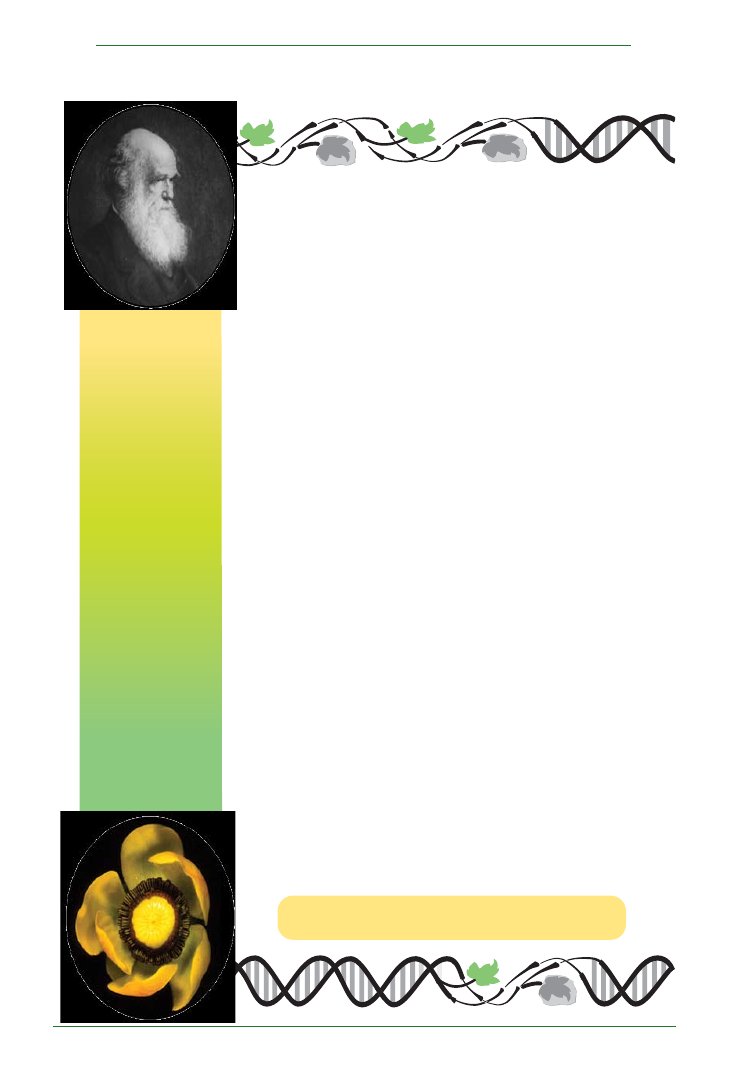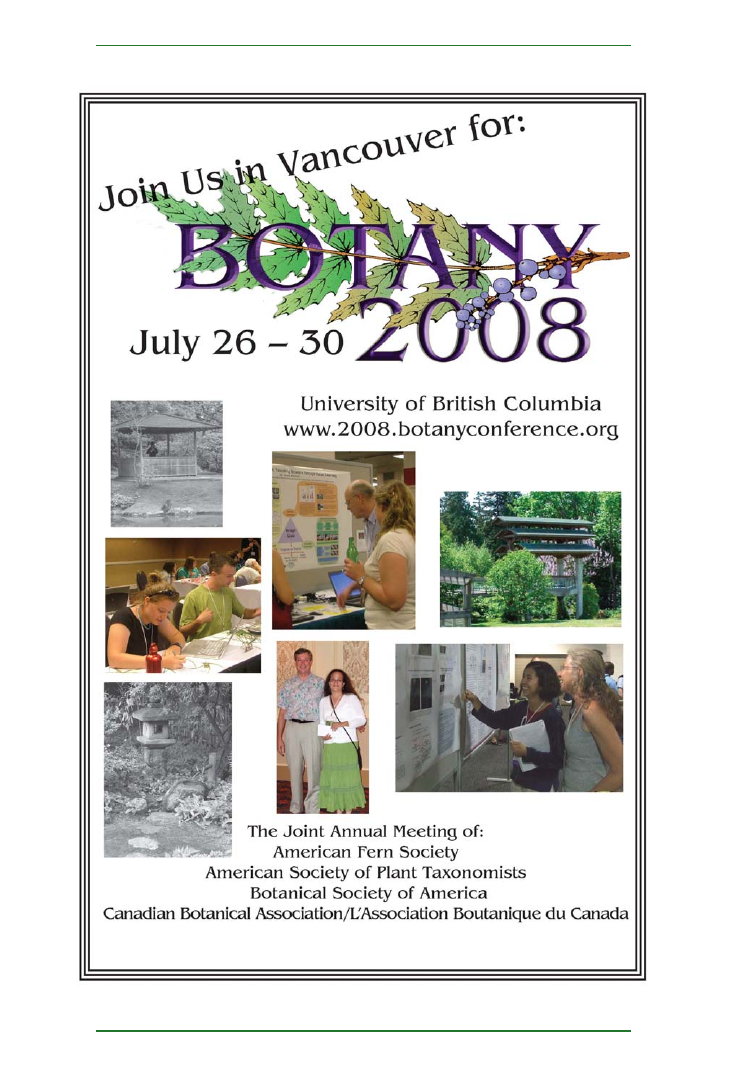
BULLETIN
FALL 2007
VOLUME 53
NUMBER 3
2@2
PLANT SCIENCE
ISSN 0032-0919
Editor: Marshall D. Sundberg
Department of Biological Sciences
Emporia State University
1200 Commercial Street, Emporia, KS 66801-5707
Telephone: 620-341-5605 Fax: 620-341-5607
Email: psb@botany.org
The Botanical Society of America: The Society for ALL Plant Biologists
Landmarks and Milestones in American Plant Biology:The Cornell Connection .........................90
The Struggle for Botany Majors...................................................................................................102
News from the Annual Meeting
Forum Keynote Address:Naturally Right by Design: Bringing Learning and
School to Life................................................................................................................103
Vision and Change in Biology Undergraduate Education: A View for the 21
st
Century.....................................................................................................................105
Awards......................................................................................................................106
Scientific Literacy, Participation, and the BSA.........................................................109
News from the Society
BSA Science Education News and Notes..................................................................112
Editor’s Choice..........................................................................................114
A Model Elementary-level Plant Science Curriculum Based on ASPB’s
‘Plant Principles’......................................................................................115
Leaf Morphology Tutorial Web Site..........................................................116
Letter to the Editor, “What are you?”.......................................................................116
Announcements
in Memoriam
Robert Hegnauer (1919 - 2007).................................................................117
Personalia
Dr. Kayri Havens Appointed Director of Plant Science and Conservation
at Chicago Botanic Garden............................................................................118
Symposia, Conferences, Meetings
54
th
Annual Systematics Symposium: “Biodiversity and Conservation
in the Andes”.............................................................................................119
Positions Available
Conservation Scientist – Ecology and Curator of Native Habitats..............120
Award Opportunities
American Philosophical Society Research Programs....................................120
Harvard University Bullard Fellowships in Forest Research.......................121
Courses/Workshops
Investigating the Evolution of Plant Form....................................................122
The Biodiversity and Taxonomy of Plants...................................................123
Other News
Darwin’s Garden: An Evolutionary Adventure...........................................................124
Canadian Journal of Botany to be renamed Botany.....................................................125
North American Botanic Garden Strategy for Plant Conservation..............................126
Book Reviews
..............................................................................................................................127
Books Received
...........................................................................................................................134
Contact Information
...................................................................................................................135
Botany 2008
.................................................................................................................................136

9 0
Plant Science Bulletin 53(3) 2007
P
LANT
S
CIENCE
B
ULLETIN
POSTMASTER: Send address changes to:
Botanical Society of America
Business Office
P.O. Box 299
St. Louis, MO 63166-0299
E-mail: bsa-manager@botany.org
Address Editorial Matters (only) to:
Marsh Sundberg, Editor
Dept. Biol. Sci., Emporia State Univ.
1200 Commercial St.
Emporia, KS 66801-5057
Phone 620-341-5605
E-mail: psb@botany.org
ISSN 0032-0919
Published quarterly by Botanical Society of America, Inc., 4475 Castleman Avenue, St. Louis,
MO 63166-0299. The yearly subscription rate of $15 is included in the membership dues of
the Botanical Society of America, Inc. Periodical postage paid at St. Louis,MO and additional
mailing office.
From July 7 through 11, Botany took Chicago by
storm with the biggest botanical event on the
continent since the St. Louis International Botanical
Congress eight years ago. It was also the first time
in three decades that the American Society of Plant
Physiologists (now Plant Biologists) met with the
Botanical Society. Many of the meeting highlights
and awards are summarized in the “News from the
Society” section.
The real highlights of this issue, however, are our
two feature articles. The first is a brief history of
botany at one of our premier institutions – Cornell
University. This is an expansion of the paper Lee
Kass gave last year at our Centennial Meeting in
Chico. I found it fascinating and asked Lee to share
her work with an article for Plant Science Bulletin.
What botany department would be better to feature
in these pages than the one that gave the Society its
first President, George F. Atkinson in 1907, and will
serve us with our next President (Karl J. Niklas,
President-elect, 2007) one hundred years later? In
addition to writing, revising, and re-revising this
article, Lee took the time to organize an excellent and
well-attended symposium on Botany in Chicago at
this year’s meeting. We hope to feature many of the
presentations from this symposium in future issues.
Our second article also features a premier botany
department. While the department of Botany and
Microbiology at the University of Oklahoma has not
had the same historical impact on Botany as Cornell,
in recent decades it has provided invaluable
leadership to the Society as we made the transition
to running independent meetings and creating a
professional business model. Wayne Elisens was
our program director (1997-1999) as we moved
from meeting annually with AIBS to running
independent BOTANY meetings and Scott Russell
was our first web-master and President 2002-3
during the period of hiring an executive director and
establishing the business office in St. Louis. But
that is not the story for now. In 2001 Gordon Uno
(who chairs the Society’s Education Committee)
became chair of the Department at Oklahoma and
began a concerted effort to strengthen and grow the
botanical component of this dual department. In
our second feature Gordon shares some of the
strategies he employs, and concerns he sees, for
building botany in colleges and universities today.
-Editor
Landmarks and Milestones in
American Plant Biology:
The Cornell Connection
ABSTRACT: Cornell University faculty, staff,
students, graduate students and post-docs made
landmark contributions to American plant biology.
Twenty-four were recognized by their election to the
U.S. National Academy of Sciences (Sections of
Botanical Science, Chemistry or Genetics). Four
who studied plants were recognized with a Nobel
Prize (J.B. Sumner, G.W. Beadle, R. Holley, B.
McClintock); eighteen served as President of the
Botanical Society of America (BSA); twenty were
BSA Merit Award winners and five received BSA
Centennial Awards. The landmarks and milestones
of Cornell “botanists” are presented.
Introduction
The Botanical Society of America’s Centennial in
2006 inspired us to examine the contributions
made to American plant biology by Cornellians in
the years since William Trelease (Cornell BS 1880)
chaired the organizing committee and became
President of the antecedent Botanical Society of
America (BSA) (1895-1905). Colleagues, who
attended our presentation at the BSA Centennial in
Chico, California (Kass 2006), encouraged us to

9 1
Plant Science Bulletin 53(3) 2007
Editorial Committee for Volume 53
Joanne M. Sharpe (2009)
Coastal Maine Botanical Gardens
P.O. Box 234
Boothbay, ME 04537
joannesharpe@email.com
Nina L. Baghai-Riding (2010)
Division of Biological and Physical Sciences
Delta State University
Cleveland, MS 38677
nbaghai@deltastate.edu
P
LANT
S
CIENCE
B
ULLETIN
Andrea D. Wolfe
(2007)
Department of EEOB
1735 Neil Ave., OSU
Columbus, OH 43210-1293
wolfe.205@osu.edu
Samuel Hammer (2008)
College of General Studies
Boston University
Boston, MA 02215
cladonia@bu.edu
Jenny Archibald (2011)
Department of Ecology and Evolutionary Biology
The University of Kansas
Lawrence, Kansas 66045
jkarch@ku.edu
publish an account of our findings to catalyze faculty
and students at other colleges and universities to
examine the contributions of botanists at their
institutions. We are pleased to have the opportunity
to do so in the Plant Science Bulletin, co-founded
by Harriet Creighton—Cornellian and past BSA
president (1956) (Kass 2005).
When the current BSA was reorganized in 1906,
from three pre-existing organizations (Smocovitis
2006), Cornell Professor of Botany George F.
Atkinson (Cornell PhB 1885) was elected its first
President (1907, Table 1). From the time Cornell
University opened its doors in 1868, faculty and
students in the Department of Botany have made
pioneering contributions to American plant biology.
This is reflected in Ewan’s (1969) Short History of
Botany in the United States, published on the
occasion of the Eleventh International Botanical
Congress, held in Seattle, Washington. (It was the
second time the congress occurred in the United
States in over 40 years.) Interestingly, Cornell
University had hosted the Fourth International
Congress of Plant Sciences in Ithaca, New York in
1926, the first year it was held in the Americas (Kass
1999). L.H. Bailey (appointed first Professor of
Horticulture at Cornell in 1888) was concurrently
President of the Congress, the AAAS, and the BSA
in that year (Table 1).
An examination of the biographical entries in
American Men of Science (AMS), from its first
publication in 1906 through the seventh edition in
1944, also provided context for this study. James
McKeen Cattell published and edited this directory
of scientists and prefixed a “star” (*, asterisks) by
the “subject of research for about 1000 of the
entries.” In 1906 he noted, “The star means that the
subject of the biographical sketch is probably among
the leading thousand students of science of the
United States; but its absence does not necessarily
mean that the subject of the sketch does not belong
in that group.” Cattell continued to assign new stars
to approximately 250 men and women of science in
each of the five later volumes, and his son Jacques
(Cattell 1944a, b) continued the practice through the
seventh edition, 1944, the year of his father’s death.
In editions five through seven (1933-1944), an index
number after the star indicated the edition of the
book in which the first star was assigned. Cattell
identified the most “eminent American Scientists of
the day” and these scientists used his stars to order
themselves, thus his system played a “major role in
the American Scientific community” (Sokal 1995).
Another perspective on the highly coveted “star” is
offered by Rossiter (1982, p. 289), “There were two
awards whose value was apparent to all in the
1920s and 1930s: a ‘star’ in the AMS, and the
supreme accolade, the Nobel Prize.” Although
women had won suffrage by the 1920s, they were
clearly concerned about their opportunities for
advancement and employment, yet few stars were
affixed to women in botany during these years. Only
six women were starred in botany between 1906
and 1944 (Rossiter 1982, p 293); two were
Cornellians and one of these won an unshared
Noble Prize in 1983.
Although Cornell botanists made many contributions
before 1906, in the interest of brevity, and in
celebration of the BSA Centennial, we begin our
story with Atkinson and concentrate on Cornell’s
Departments of Botany and herbaria; reserving the
extensive contributions of Cornell’s earlier botanists
for another time.
Contributions from Cornell’s First Notable
Department of Botany (1868-1921)
Prentiss and Atkinson’s Department of Botany
George F. Atkinson (1854-1918), first president of
the reorganized BSA, studied with Albert N. Prentiss,
Cornell’s first Professor and Chair of Botany (1868-
1896). Prentiss had also influenced students who
studied the local flora (David Starr Jordan, Cornell’s

9 2
Plant Science Bulletin 53(3) 2007
first MS 1872; William R. Dudley, Cornell BS 1874,
MS 1876), and inspired many who became notable
botanists (Joseph C. Arthur, Cornell DSc 1886;
Frederick V. Coville, Cornell AB 1887; W.R. Dudley;
Charles F. Millspaugh, in residence 1871-73; Willard
W. Rowlee, Cornell BL 1887, DSc 1893; and W.
Trelease) (Tables 1, 2, 3).
Atkinson replaced William R. Dudley (1849-1911),
who had been an undergraduate instructor at
Cornell (1874) and the first Assistant Professor in
its Department of Botany (1876-1883). David Starr
Jordan, the department’s first instructor in botany,
became the founding president of the newly
established Leland Stanford Jr. University, where
he appointed Dudley as one of their first professors
of Botany in 1892. (Most of Dudley’s herbarium
followed him to Stanford and is currently at CAS).
Upon the death of Prentiss in 1886, Atkinson became
head of Cornell’s Department of Botany, until his
death in 1918. That same year, Atkinson was
elected to the US National Academy of Sciences
(NAS) (Table 2). Within a few years, his former
department (by then in the College of Arts and
Sciences) would close and the New York State
College of Agriculture’s (NYSCA) Department of
Botany (established in 1913) would continue
Cornell’s pioneering contributions (see below).
Distinguished for his research with fungi, Atkinson
was also a respected teacher of General Botany
and Zoology. He encouraged young botanists, both
male and female. Three of his more notable students
were Elias J. Durand (Cornell AB. 1893, ScD. 1895),
Benjamin M. Duggar (1872-1956; Cornell PhD 1898)
and Margaret Clay Ferguson (1863-1951; Cornell
AB 1899, PhD 1901), all of whom were starred in
AMS (Table 3).
Duggar, instructor (1896-1900) and assistant
professor (1900-1901) in Cornell’s Department of
Botany, would soon head the first Department of
Plant Physiology (1907-1912) in the NYSCA at
Cornell. He was appointed by L.H. Bailey, who had
succeeded Isaac P. Roberts as Dean of the College
of Agriculture (1903) and had secured funds from
New York State to establish the New York State
College of Agriculture at Cornell University in 1904.
Plant Physiology merged with the new Department
of Botany (established 1913), when Duggar left
Cornell for Washington University, in St. Louis,
Missouri. Duggar was awarded a star in Plant
Physiology in the first edition of AMS (1906, Table 3)
and published the first text on the subject of Fungous
Diseases of Plants in 1909. He was President of the
BSA (1923), General Secretary and Chairman of the
Executive Committee for the Fourth International
Congress of Plant Sciences (1926), and edited its
Proceedings (Duggar 1929). In 1948, at age 71,
Duggar reported the first broad-spectrum antibiotic,
Aureomycin, produced by Streptomyces
aureofaciens. At the 1956 Golden Jubilee
celebration of the BSA, Duggar, along with four other
Cornellians, received one of the society’s first Merit
Awards (Table 4). He was acknowledged for
outstanding research in plant physiology, plant
pathology, and mycology, and for providing
inspiration, and high standards of scholarship to
many students.
One of those students, Margaret C. Ferguson, while
pursuing a doctorate in botany with Atkinson, had
also conducted a study of the common edible
mushroom under the direction of Duggar, during
1900-1901. In 1902, she published the first
successful method for germinating spores of
Agaricus campestris. Previously, French scientists
held the secret for successful germination of this
fungus. Starred in Botany in the second edition of
AMS (1910), Ferguson was also the first woman
elected Vice President of the BSA (1922) and the
first woman elected its President in 1929. She was
head of the Botany Department of Wellesley College,
Wellesley, Mass., and encouraged many students
to become botanists. Harriet B. Creighton, for
example, was awarded a graduate assistantship in
Cornell’s Department of Botany, in 1929, on
Ferguson’s recommendation (Kass 2005).
Contributions from Cornell’s NYS College of
Agriculture: Department of Botany (1913-1964) &
L.H. Bailey Hortorium (1935-1999)
More Notable Botany Departments
Liberty Hyde Bailey(1858-1954), as Dean (1903-
1913) of the NYSC at Cornell, established many
new departments related to botanical sciences
and served as the Director of the Cornell Agricultural
Experiment Station until 1913. Dean Bailey
appointed former students and colleagues, from
Cornell and elsewhere, to professorships in his
newly established departments (Coleman 1963;
also see below). Bailey reported the first detailed
study of plant growth under artificial light (1893). He
published over 1,000 articles and technical and
popular books, the more influential being his
Standard Cyclopedia of Horticulture (1914-1917),
Manual of cultivated plants (1924, 1
st
ed.; revised
1949), and Hortus Second (1941) with his daughter
Ethel Zoe Bailey (1889-1983). Hortus Third (1976)
was revised and expanded by the staff of the L.H.
Bailey Hortorium. In addition to serving as an officer
of the BSA (Table 1), Bailey was also honored with
a star in botany in the first edition of AMS (1906), and
elected to the NAS in 1917. In 1935, at Cornell
University, Bailey and his daughter Ethel Zoe

9 3
Plant Science Bulletin 53(3) 2007
established the L.H. Bailey Hortorium (BH), one of
the first U.S. herbaria of cultivated plants, and, by the
1950s, one of the foremost palm herbaria of the
world. Bailey was the Hortorium’s first director and
daughter Ethel Zoe was appointed the first curator.
One of Bailey’s final duties as dean of the NYSCA
was to recall Professor Karl McKay Wiegand (1873-
1943) from Wellesley College in 1913, to head the
newly established Department of Botany in the
NYSCA, and to invite Rollins Adams Emerson to
head the Department of Plant Breeding (1914),
which Bailey had established in 1907 (with H.J.
Webber as its first head). Wiegand had earned his
PhD at Cornell in 1898 and was appointed assistant
then instructor there from 1894 through 1907. While
there, he met and married Ella Maude Cipperly
(Cornell AB 1904). Wiegand was then appointed
Professor of Botany at Wellesley College (1907-
1913) and was soon recognized with a star in
Botany in the second edition of AMS (1910). He was
elected President of the BSA in 1939.
Wiegand’s Department of Botany
Wiegand hired many notable botanists (Figure 1)
who brought honors to his department by their
inspirational teaching, pioneering research, and
technical and educational publications. The staff in
Wiegand’s newly established Department of Botany
included Assistant Professor Lewis Knudson (who
was transferred from the former Department of
Plant Physiology, when Duggar left Cornell) and five
instructors, among whom were: Arthur J. Eames,
graduate of Harvard University (who was transferred
from Atkinson’s Department of Botany); Wiegand’s
spouse, Maude C. Wiegand, former Instructor in
Botany at Wellesley College; Otis Freeman Curtis
(Cornell PhD 1916), later assistant professor (1917)
then professor (1922) of Plant Physiology, and
William J. Robbins (Cornell PhD 1915) who later
became Head of the Department of Botany at the
University of Missouri, where he pioneered
experiments on tissue culture. Soon after, Robbins
became Dean of their Graduate School, later on
Director of the New York Botanical Garden, and
ultimately President of Fairchild Tropical Garden. In
addition, Wiegand had six assistants; the most
notable is Laurence H. MacDaniels (Cornell PhD
1917), who with Eames wrote an influential text in
plant anatomy (Table 5). MacDaniels later served
as head of Cornell’s Department of Floriculture and
Ornamental Horticulture (1940-1956).
Wiegand’s first research project at Cornell was to
continue his graduate student project, a study of the
local flora, in collaboration with A.J. Eames (1881-
1969), and in cooperation with graduate students,
staff, and other faculty members. This resulted in
The Flora of the Cayuga Lake Basin, New York
(1925, Table 5), which was an expansion of Dudley’s
(1886) Cayuga Flora published 40 years previously.
The plant specimens that Wiegand’s group
collected were an important resource for
documenting the local flora, and the NYSCA
Department of Botany Herbarium was an outcome
of this project. When Atkinson’s former department
was closed, around 1921, Wiegand arranged for
the transfer of the previous Department of Botany
herbarium [based originally on the important
collections of Horace Mann Jr. (1844-1868)] to the
NYSCA Department of Botany. Wiegand then
merged his department’s herbarium with the earlier
herbarium to form CU (named Wiegand Herbarium,
in 1951, after Wiegand’s death in 1942). In 1977, the
herbaria of CU and BH were merged. Thus Cornell’s
world-renowned herbaria—The original Cornell
University Herbarium, The Wiegand Herbarium,
and The Bailey Hortorium Herbarium—were finally
one.
One of Wiegand’s more notable students, Bassett
Maguire (Cornell PhD 1938), later a staff member
of the New York Botanical Garden, directed the first
of 42 expeditions to the sandstone Guayana
Highland of northern South America (Howard and
Moon 1990).
Eames was soon recognized with a star in Botany
in the fourth edition of AMS (1927). He served the
BSA as secretary (1927-1931), Vice President
(1932), and President (1938), and was honored
with one of the first BSA Merit Awards (1959) for his
“sustained researches on the morphology and
Figure 1. Cornell’s Department of Botany Faculty (1931)
Top row, left to right: Karl M. Wiegand, Walter C. Muenscher,
E.M. Weller (visitor), Edwin F. Hopkins, R.B. Thompson
(visitor), Lester W. Sharp.
Bottom row, left to right: Arthur J. Eames, Loren C. Petry,
Donald Reddick, Otis F. Curtis. (Courtesy of L.H. Bailey
Hortorium Archives)

9 4
Plant Science Bulletin 53(3) 2007
anatomy of vascular plants and for his noteworthy
contributions to our knowledge of floral development
and evolution.” One of Eames’ notable students is
Natalie Browning Whitford (Cornell MS 1943, PhD
1947) (see Natalie W. Uhl below).
The staff of Wiegand’s Department of Botany was
enlarged with appointments of notable botanists,
Jacob R. Schramm, Loren C. Petry, Walter C.
Muenscher, and Lester W. Sharp. Schramm (1885-
1976) joined Wiegand’s department in 1915 as
Assistant Professor of Botany (Professor 1917-
1925). He was editor-in-chief of Botanical Abstracts
from 1921-1925 and founder and first editor-in-
chief of Biological Abstracts [now Biosis] (1924-
1937), first issued in December 1926. Schramm
had been secretary of the BSA (1918-1922), elected
Vice President (1923) and later its President in
1925. He was starred in Botany in the third edition
of AMS (1921) and was honored with the Botanical
Society of American’s Merit Award (1969) for his
studies of the “ecology of the black mining wastes
of the Pennsylvania anthracite region,” and for his
work as editor of Biological Abstracts.
Petry (1887-1979), a paleobotanist and
distinguished teacher, was hired at Cornell in 1925.
Vice-President of the BSA in 1937, and starred in
Botany in the sixth edition of AMS (1938), he was
also honored with a BSA Merit Award as an “unusually
effective botanical teacher, who has skillfully guided
the careers of thousands of students in the right
direction, and a wise and generous counselor in
scientific affairs” (Tables 1, 3, 4). Petry’s most
notable student was Harlan P. Banks (Cornell PhD
1940) (see below).
Muenscher (1891-1963, Cornell PhD 1921), known
as the “Wizard of Weeds,” and an eminent American
scientist (Table 3), received a BSA Merit Award in
1960 for “many distinguished contributions,
especially his books on weeds, aquatic plants,
poisonous plants and garden herbs (Table 5). His
lifelong devotion to all phases of botany has
stimulated the lives and careers of his numerous
students.” Many readers of this article may recall
keying out their first early spring wild flowers or
woody plants using Muenscher’s books.
Sharp (1887-1961), a graduate of the University of
Chicago, joined Wiegand’s department as an
instructor in 1914 (Professor in 1920). Sharp was
the major professor of Barbara McClintock (Cornell
BS 1923, MA 1925, PhD 1927; Nobel Laureate
1983), and Harriet Creighton (Cornell PhD 1933),
and was on the PhD committees of R.A. Emerson’s
students, George W. Beadle (Cornell PhD 1930;
Nobel Laureate 1958) and Marcus M. Rhoades
(Cornell PhD 1932).
Two years after McClintock arrived at Cornell, Sharp
published the first edition of his world-renowned
textbook, Introduction to Cytology (1921).
McClintock, who would become Sharp’s most
notable graduate student and the Department of
Botany’s most famous alumna, used this text while
enrolled in Sharp’s cytology class the same year it
was issued. The third edition of Sharp’s cytology
book (1934) included unpublished research of his
distinguished students, McClintock and Creighton.
Sharp’s keen wit and non-conformist outlook
produced such works as Eoörnis pterovelox
gobiensis (1928), a spoof on scientific inquiry and
pompous investigators, and A Nuclear Century
(1931) his poetic address upon retiring as BSA
President (Table 1, see Kass 2005). Sharp served
as Secretary of the 1926, Fourth International
Congress of Plant Sciences Program Committee
(Schramm was Chair) and was a member of the
Executive Committee. Within a few years he was
elected Vice President (1929) and President (1930)
of the BSA, and was a member of the editorial board
of the American Journal of Botany (1932-1937). He
was awarded a star in Botany, in the fourth edition
of AMS (1927), and was honored with a BSA Merit
Award (1958) for his contributions, which “made
plant cytology a significant field of botany.”
Cooperation with Emerson’s Department of Plant
Breeding:Golden Age of Plant Cytogenetics at
Cornell
Many students majoring in other departments at
Cornell studied with faculty in the Department of
Botany; most notable were students who came to
work with R.A. Emerson (1873-1947), head of
Cornell’s Plant Breeding Department (1914-1942).
Emerson had established a school of plant genetics
at Cornell, a milestone comparable to T.H. Morgan’s
school of Drosophila genetics at Columbia
University (Kass, Bonneuil & Coe 2005). Barbara
McClintock (1902-1992), as an instructor in the
Department of Botany (1927-1931), provided
guidance and leadership to Emerson’s students,
G.W. Beadle, M.M. Rhoades, and post-doctoral
National Research Council Fellow Charles R.
Burnham (1929, 1930) (Figure 2), and in her own
department to H.B. Creighton (see also Kass 2007).
Rhoades, a 1962 BSA Merit Awardee, and a student
in Plant Breeding and Botany at Cornell during the
Golden Age of maize genetics, has reviewed the
cooperative efforts that this group of students had
made towards furthering the field of plant
cytogenetics (Rhoades 1984, Kass & Bonneuil
2004).
We will mention only a few of McClintock’s landmark
publications, which Rhoades (1984) emphasized
(see Kass & Bonneuil 2004). While McClintock was
still a graduate student, she and L.F. Randolph
(Cornell PhD 1921) published the first report of a

9 5
Plant Science Bulletin 53(3) 2007
.
triploid corn plant and described the behavior of its
chromosomes (Randolph & McClintock 1926, see
Kass 2003). By June of 1929, Instructor McClintock
had published the first ideogram of corn
chromosome morphology illustrating the 10 haploid
chromosomes in the first mitotic division of the
microspore (McClintock 1929; see Kass 2003). By
1930, McClintock had published the first cytological
description of pachytene chromosomes in corn; the
movement of the chromosomes (in a translocation
heterozygote) provided an explanation for semi-
sterility in a strain of corn plants that Burnham had
brought with him from Wisconsin. With botany
student Henry E. Hill, McClintock published the first
paper linking a gene to a chromosome in corn,
using cytological methods and trisomic ratios
(McClintock & Hill 1931, see Kass & Bonneuil
2004).
But McClintock’s most noted early contribution is
the paper she published with graduate student
Harriet Creighton in 1931, on the first demonstration
of crossing over at the cytological level (McClintock
1931, Creighton and McClintock 1931, see Kass
2005). Creighton’s crossing-over paper was the
basis for her PhD dissertation (1933), which was
suggested by McClintock. Their landmark study
provided additional proof for T.H. Morgan’s
chromosome theory of heredity, for which he won a
Nobel Prize in 1933 (Coe & Kass 2005).
Creighton (1909-2004) left Cornell in 1934 and later
became head of the Botany Department at Wellesley
College. She retired as Ruby F.H. Farwell Professor
Emerita. Creighton was the third woman President
of the BSA in 1956 (Vice-President, 1955), and the
first woman elected secretary of the BSA (1950-
1954). She was editor of the Plant Science Bulletin
(1958) and made many behind-the-scenes
contributions to botanical education. Even after
retirement, she was recognized for her contributions
to botanical science with the Large Gold Medal of
the Massachusetts Horticultural Society (1985)
(Kass 2005).
More notable plant scientists
Even before McClintock was recognized for her
Nobel Prize winning research, she was starred in
Botany in AMS (1944) and, soon after her major
papers on mobile genetic elements and gene
expression were published, the BSA honored her
with their 1957 Merit Award (Kass 2007). In addition
to McClintock and those students mentioned
previously, the Department of Botany boasts many
other influential and prominent students of the
botanical sciences. For example, in 1934, Adriance
S. Foster (Cornell BS 1923, see Hirsch & Kirchanski
2006) became the first plant anatomist in the newly
reorganized Department of Botany, University of
California, Berkley; Sterling Emerson (Cornell BS
1922), son of R.A. Emerson, became Professor at
the California Institute of Technology and a member
of the NAS; Chester A. Arnold (Cornell PhD 1928)
was Curator of Fossil Plants at University of
Michigan; Paul R. Burkholder (Cornell PhD 1929)
pursued quantitative studies on auxins and was
elected to the NAS in 1949; Stanley J. Smith (Cornell
MS 1939) was Curator of Botany, New York State
Museum, Albany, NY; Arthur W. Galston (Cornell BS
1940), Professor of Plant Physiology, Yale University,
is the author of notable plant biology textbooks, and
has made pioneering studies on plant hormones
and plant growth and development; and Natalie W.
Uhl, (Cornell PhD 1947), Professor Emerita, L.H.
Bailey Hortorium, Department of Plant Biology, and
a BSA Centennial winner, co-authored with John
Dransfield (1987) the celebrated Genera Palmarum:
A Classification of Palms Based on the Work of
Harold E. Moore, Jr., recently revised (in press).
Furthermore, in addition to Creighton, Cornellians
served as Secretary of the BSA (Table 1).
Expansion of Cornell’s Department of Botany
Soon, other professors joined Cornell’s Department
of Botany and made notable contributions to their
fields. Among these was Daniel Grover Clark
(Cornell PhD 1936) who with O.F. Curtis authored
a well-known textbook on plant physiology (Table
5). Harlan P. Banks succeeded Petry in 1949 and
became head of the department after Knudson
stepped down in 1952. Banks authored many
influential publications in the field of paleobotany,
concentrating on the evolutionary history of early
land plants (Banks 1970). He served as BSA
Figure 2. Maize Researchers, Cornell University Emerson
Garden, 1929
Left to right: Charles R. Burnham (National Research
Council Fellow), George W. Beadle (kneeling, PhD 1930),
Marcus M. Rhoades (PhD1932), Professor Rollins A.
Emerson (Head, Department of Plant Breeding), Instructor
Barbara McClintock (PhD 1927). (Courtesy of W.B. Provine)

9 6
Plant Science Bulletin 53(3) 2007
President and Treasurer (Table 1), received a BSA
Merit Award (1975) for distinguished teaching of
undergraduate and graduate students and for
numerous contributions to our knowledge of early
land vegetation, and was elected to the NAS (Table
2). Frederick C. Steward, first to show that a single
cell from a vegetative plant can be cultured to
produce a whole plant, joined the department in
1950, was elected to the Royal Society (the national
academy of sciences of the UK) in 1957, and
honored with a BSA Merit Award (1961). (McClintock
was elected a Foreign Member of the Royal Society,
in 1989.) Tables 1-4 include additional Cornell
plant scientists or geneticists who have made
notable contributions to their fields. A few share
joint appointments in the current Department of
Plant Biology (see below).
A New Vision for Botany at Cornell: A Department
of Plant Biology
With the creation of a Division of Biological Sciences
within NYSCA at Cornell in 1964, members of the
Department of Botany, which Bailey had established
in 1913, joined with a few faculty members from the
Departments of Zoology and Plant Breeding to form
a new unit called the Section of Genetics,
Development and Physiology (GDP, established
1965; and CU herbarium became a separate unit
within NYSCA; Table 6); Cornell’s formerly
distinguished Department of Botany had
disappeared! In 1965, Barbara McClintock returned
to this new Section as one of the first Andrew
Dickson White Visiting Professors-at-Large. She
visited the campus once or twice a year for the next
10 years, hosted by geneticists Adrian M. Srb, Bruce
Wallace (Table 2) and Section Chair Harry Stinson.
New faculty interested in plant growth and
development soon joined the Section (we mention
only a few)—Andre T. Jagendorf (Cornell BS 1948;
hired 1966), L.H. Bailey Professor Emeritus, was
responsible for discoveries on biochemical
reactions in photosynthesis; he provided
experimental evidence for hydrogen ion gradients
across membranes as an energy intermediate, a
hypothesis proposed by Mitchell (and for which
Mitchell was awarded a Nobel Prize). Roderick K.
Clayton, who unraveled mysteries of how light
energy is trapped, joined the Section in the same
year (retired 1983). Jagendorf and Clayton were
elected to the NAS (Table 2). Recently (July 2007),
Jagendorf received one of the first Fellow of the
American Society of Plant Biology (ASPB) Awards,
granted in recognition of distinguished and long
term contributions to plant biology and service to
the Society. In 1977, the name of the Section of GDP
was changed to Botany, Genetics and Development
(BGD), which more accurately reflected the interests
of its members (and CU herbarium merged with BH
herbarium; see Table 6). Earlier (1971), NYSCA
had been renamed The New York State College of
Agriculture and Life Sciences at Cornell (CALS). By
1980, the Section was separated into a Section of
Plant Biology and a Section of Genetics and
Development. New faculty members were recruited
for positions in the Section of Plant Biology. Karl J.
Niklas, L.H. Bailey Professor, was hired to fill the
position vacated by Banks in 1978. Niklas, former
editor-in-chief of the American Journal of Botany
(1995-2004) and a BSA Merit Award winner (1996),
authored several books including The Evolutionary
Biology of Plants (1997) and recently received a BSA
Centennial Award. He is currently BSA President
elect (Table 1). June B. Nasrallah, who had received
her PhD (1977) in the former Section of Genetics,
Development and Physiology, with Professor Adrian
M. Srb (a former student of G.W. Beadle), was hired
in 1985. J. Nasrallah was recently elected to the
NAS for her exemplary studies on self-incompatibility
in Brassica, joining other Cornell plant biologists
who have received such distinction (Table 2). She
occupies the first Barbara McClintock Professorship
in the Department of Plant Biology (CALS).
The Legacy of Liberty Hyde Bailey
When the Division of Biological Sciences was
dissolved in 1999, the Section of Plant Biology and
the L.H. Bailey Hortorium Herbarium were joined.
The circle was completed and Cornell’s
Departments of Botany and herbaria were once
again united in a single Department of Plant Biology
(Table 6), currently chaired by William L. Crepet, a
recent BSA Merit Awardee.
Cornell’s Notable Botanists
Nobel Laureates
At the 1957 BSA Banquet, retiring President Harriet
Creighton suggested that we make clear that botany
includes the study of all plants and that we “call
ourselves botanists with some pride in our voices.”
We are proud to recognize four Nobel Laureate
Cornellians who have made major contributions to
science using plants as their research organisms.
(We remind our readers that fungi were still
considered plants until 1968.) Barbara McClintock
received an unshared Nobel Prize in Physiology or
Medicine (1983) for her “discovery of mobile genetic
elements” (Indian corn); George W. Beadle, shared
a Nobel Prize in Physiology or Medicine (1958) for
the “discovery that genes act by regulating definite
chemical events” (Bread mold); Robert W. Holley
(Cornell PhD 1947) shared a Nobel Prize in
Physiology or Medicine (1968) for the “interpretation
of the genetic code and its function in protein
synthesis” (yeast); and James B. Sumner shared a
Nobel Prize in Chemistry (1946) “for his discovery

9 7
Plant Science Bulletin 53(3) 2007
that enzymes can be crystallized” (Jack Bean meal).
It is interesting to note that Sumner’s first publication
of the crystallization of urease extracted from Jack
Bean meal [Canavalia ensiformis (L.) DC], in 1926,
provided a further demonstration that the urease
enzyme is a protein. His work was based on the
research of his graduate student Viola Arvin Graham,
who provided the initial Experimental proof of the
protein nature of urease for her PhD (1925), awarded
the previous year. In his Nobel Prize acceptance
speech, Sumner acknowledged the collaborative
efforts of “V.A. Graham,” giving no indication that
Graham was a woman.
Cornellian-National Academy of Sciences
members, BSA Merit/Centennial Awardees and
American Men of Science Honorees
Between 1902 and 2003 a considerable number of
Cornellians, who conducted research with plants,
were elected to the United States NAS (Table 2). In
the early years, members were elected to specific
sections of the NAS (i.e. Botany) on
recommendations from Academy members in that
section. Many academy members were also former
officers of the BSA (Table 1) and were starred in AMS
(Table 3).
The Botanical Society of America celebrated its 50th
Golden Jubilee Anniversary in 1956, by awarding
Certificates of Merit to 50 botanists in all botanical
fields. As BSA President in 1956, Harriet Creighton
presented these honors to four former Cornellians:
B.M. Duggar, A.J. Eames, W.J. Robbins, and G.W.
Beadle. In that year, a study based on the seventh
edition of AMS (1944) revealed that Cornell University
ranked in the top three American Universities in
graduating PhDs in Botany (Greulach 1956). Sixteen
percent of the botanists newly starred in the seventh
edition of AMS, had graduated from Cornell University
(Table 3, see Cattell 1944).
In the second 50 years of the BSA, 16 additional
Cornellians were presented with BSA Merit Awards
(Table 4). And in 2007, a Cornell University plant
biologist has been privileged to accept this tribute
(Table 4). The 100
th
anniversary of the BSA was
celebrated at BOTANY 2006, in Chico, California,
with 100 plant biologists receiving Centennial
Awards. Five Cornellians were so honored: W.
Hardy Eshbaugh (Cornell BA 1959), Jack B. Fisher
(Cornell BS 1965, MS 1966), Karl J. Niklas, Dominick
J. Paolillo, Jr. (Cornell BS 1958), and Natalie W. Uhl
(Cornell PhD 1947), (Figure 3). We are also proud
that V. Betty Smocovitis (Cornell PhD 1988), the
BOTANY 2006 keynote speaker and botanical
historian, received her botanical training in Cornell’s
Section of Plant Biology.
We can conclude that modern plant taxonomy has
caused a diaspora for the former plant kingdom,
having some of its past members now dispersed
throughout other kingdoms of the natural world. Yet,
as Creighton suggested, we can still be proud of all
researchers who work with plants, fungi, and bacteria
(and study their history), even though they may not
currently consider themselves Botanists.
Acknowledgments. We gratefully acknowledge The
Division of Rare and Manuscript Collections, Cornell
University Library, and the L.H. Bailey Hortorium
Library and Archives, Cornell University, for
assistance with documentation; The Department
of Plant Biology and The Department of Plant
Breeding & Genetics, Cornell University, for logistical
support; Members of the former Sections of
Genetics, Development & Physiology and Botany,
Genetics & Development, and Members of The L.H.
Bailey Hortorium for insights and documents,
especially Robert Dirig, for thoughtful discussion
and reviewing earlier drafts of the manuscript;
Professor Dominick Paolillo, who gifted LBK his
copy of Ewan’s history when she was his graduate
student at Cornell in the early 1970s; Professor
Richard Korf, Department of Plant Pathology, for
bringing Ferguson’s publication and other
documents to our attention; Professors R.P. Murphy,
K. Gale, R.H. Whalen, A.T. Jagendorf, R.P. Korf, D.M.
Bates, with special thanks to K.J. Niklas, for
suggested revisions to the manuscript. LBK
conducted part of these investigations under the
auspices of NSF grants SBR9511866 &
SBR9710488.
Literature Cited:
Figure 3. BSA Centennial Award winners with William L.
Crepet, Chair of their Department of Plant Biology, Cornell
University. Left to right: Dominick J. Paolillo, Jr., W.L.
Crepet, Karl J. Niklas, and Natalie W. Uhl. (photo by Ed Cobb,
9 June 2007)

9 8
Plant Science Bulletin 53(3) 2007
Cattell JM (editor). 1906 1
st
ed., 1910 2
nd
ed., 1921 3
rd
ed.,
1927 4
th
ed., 1933 5
th
ed. American Men of Science: A
Biographical Directory. The Science Press, New York,
NY.
Cattell, JM and J Cattell (editors). 1938 6
th
ed. American
Men of Science: A Biographical Directory, The Science
Press, New York, NY.
Cattell, J (editor). 1944a 7
th
ed. American Men of Science:
A Biographical Directory, The Science Press, Lancaster,
PA:
Cattell, J 1944b. American Men of Science: Scientific men
receiving stars in the seventh edition. Science 100 (No.
2589, Aug.): 126-129.
Banks, HP 1970. Evolution and plants of the past.
Wadsworth Pub. Co., Belmont, Calif.
Coe, E and LB Kass. 2005. Proof of physical exchange of
genes on the chromosomes. Proceedings of the National
Academy of Science 102 (No. 19, May): 6641-6646.
Coleman, GP. 1963. Education and Agriculture, A History
of the New York State College of Agriculture at Cornell
University. Cornell University, Ithaca, New York.
Duggar, BM (editor). 1929. Proceedings of the International
Congress of Plant Sciences, Ithaca, New York, August
16-23, 1926. George Banta Publishing Company, Menasha,
Wis.
Dudley, WR 1886. The Cayuga Flora. Part I: A Catalogue
of the Phaenogamia Growing Without Cultivation in the
Cayuga Lake Basin: Ithaca, N.Y., Andrus & Church.
Ewan, J (editor). 1969. A Short History of Botany in the
United States. Hafner Pub. Co., New York. [International
Botanical Congress 11
th
: 1969, Seattle Washington]
Ferguson, MC 1902. A Preliminary Study of the Spores of
Agaricus campestris and other Basidiomycetous Fungi.
USDA, Bureau of Plant Industry, Bulletin No. 16, Washington,
Government Printing Office.
Graham, Viola A. 1925. Experimental Proof of the Protein
Nature of Urease. PhD Thesis, Cornell University, Ithaca,
N.Y.
Greulach, VA. 1956. Origins of American Botanists. Plant
Science Bulletin 2(1, Jan.): 4-6.
Hirsch, AM and SJ Kirchanski. 2006. Adriance S. Foster,
an academic grandchild remembers. Plant Science Bulletin
52 (2, spring): 42-45.
Howard, RA and BM Moon. 1990. Bassett Maguire—An
annotated biography, in The Bassett Maguire Festschrift:
A Tribute to the Man and his Deeds, edited by William R.
Buck, Brian M. Boom, and Richard A. Howard. Memoirs
of the New York Botanical Garden. Volume 64, Bronx, NY.
Kass, LB. 1999. Barbara McClintock and the 1926
International Botanical Congress. XVI International
Botanical Congress, Abstracts. Pg. 474.
Kass, LB. 2003. Records and recollections: A new look
at Barbara McClintock, Nobel Prize-Winning geneticist.
Genetics 164 (August): 1251-1260.
Kass, LB. 2005. Harriet Creighton: Proud botanist. Plant
Science Bulletin. 51(4): 118-125.
Kass, LB. 2006. Landmarks and milestones in American
Plant Biology; The Cornell connection. Botany 2006,
Abstracts, Scientific Meeting, July 29-August 2, 2006:
Abstract #751, Pg. 340. http://
www.2006.botanyconference.org/engine/search/
index.php?func=detail&aid=522
Kass LB. 2007. Barbara McClintock (1902-1992), on
Women Pioneers in Plant Biology, American Society of
Plant Biologists website, Ann Hirsch editor. Published
online, March 2007:
h t t p : / / w w w . a s p b . o r g / c o m m i t t e e s / w o m e n /
pioneers.cfm#McClintock
Kass, LB and C Bonneuil. 2004. Mapping and seeing:
Barbara McClintock and the linking of genetics and cytology
in maize genetics, 1928-1935. Chap. 5, pp. 91-118, in
Classical Genetic Research and its Legacy: The Mapping
Cultures of 20th Century Genetics, edited by H.J.
Rheinberger and J.P. Gaudilliere. London: Routledge.
Kass, LB, C Bonneuil, and E Coe. 2005. Cornfests, cornfabs
and cooperation: The origins and beginnings of the Maize
Genetics Cooperation News Letter. Genetics 169 (April):
1787-1797.
Niklas, KJ. 1997. The Evolutionary Biology of Plants.
University of Chicago Press, Chicago, IL
Rhoades, MM. 1984. The early years of maize genetics.
Annual Review of Genetics 18:1-29.
Rossiter, MW. 1982. Women Scientists in America,
Struggles and Strategies to 1940. The Johns Hopkins
University Press, Baltimore, MD.
Smocovitis, VB. 2006 One hundred years of American
botany: a short history of the Botanical Society of America.
American Journal of Botany 93: 942-952.
Sokal, M. 1995. Stargazing: James McKeen Cattell,
American Men of Science, and the reward structure of the
American scientific community, 1906-1944, pp. 64-86, in
Psychology, Science, and Human Affairs: Essays in honor
of William Bevan, edited by Frank Kessel. Westview
Press, Bolder, CO.
Sumner JB. 1926. The isolation and crystallization of the
enzyme urease. Journal of Biological Chemistry 69:
4355–4441.
Uhl, NW and J Dransfield. 1987. Genera Palmarum: a
classification of palms based on the work of Harold E.
Moore, Jr., with illustrations by Marion Ruff Sheehan; L.H.
Bailey Hortorium, Ithaca, N.Y., International Palm Society
(Allen Press, Lawrence, Kansas).
Dransfield, J, NW Uhl, CW Asmussen, WJ Baker, MM
Harley, CN Lewis. Genera Palmarum: Evolution and
Classification of Palms, 2
nd
edition (In Press).
Bibliography:
Atkinson, GF. 1896. Albert Nelson Prentiss. Botanical
Gazette XXI (May): 283-289.
BH, Herbarium of the LH Bailey Hortorium, Cornell University
http://bhort.bh.cornell.edu/herb.htm
(accessed 6 June
2007).
otanical Society of America Membership Directory and
andbook, 2005. Botanical Society of America, St. Louis,
MO.
Dudley Memorial Volume, Containing a Paper by William
Russel Dudley and Appreciations and Contributions in
his Memory by Friends and Colleagues. 1913. Stanford,
California.
Fitzpatrick, HM. 1926. An Historical Sketch of the Early
Days of Botany at Cornell. Unpublished manuscript in the
Department of Plant Pathology reprint collection, Cornell
University, Ithaca New York.
Fifty Years of Research at the Cornell University
Agricultural Experiment Station, 1887-1937. Cornell
University Agricultural Experiment Station. Ithaca, New
York.
Horace Mann, Jr. (1844-1868). http://bhort.bh.cornell.edu/
mann.htm (accessed 6 June 2007).
Kass, LB. 2000. Barbara McClintock, *Botanist, cytologist,

9 9
Plant Science Bulletin 53(3) 2007
geneticist. American Journal of Botany 87(6): 64.
Knudson, L. 1938. A Brief History of the Department of
Botany [New York State College of Agriculture].
Unpublished manuscript, in the Department of Plant Biology
files, Cornell University, Ithaca, New York.
Leonard, JW. (editor). 1914. Woman’s Who’s Who of
America, A Biographical Dictionary of Contemporary
Women of the United States and Canada, 1914-1915. The
American Commonwealth Company, N.Y.
National Academy of Sciences, Membership Directory:
h t t p : / / w w w . n a s o n l i n e . o r g / s i t e /
Dir?sid=1011&view=basic&pg=srch
;
Deceased Member Data:
h t t p : / / w w w . n a s o n l i n e . o r g / s i t e /
Dir?sid=1021&view=basic&pg=srch.
Nobel Prize.org. All Nobel Laureates (by year beginning in
1901):
http://nobelprize.org/nobel_prizes/lists/all/
One hundred Years of Agricultural Research at Cornell
University: A Celebration of the Centennial of the Hatch
Act, 1887-1987. Office for Research, College of Agriculture
and Life Sciences, Cornell University, Ithaca, N.Y.
Plant Pathology Herbarium (CUP), Cornell University:
http://www.plantpath.cornell.edu/CUPpages/CUP.html.
Royal Society, London: List of Royal Society Fellows,
http://www.royalsoc.ac.uk/page.asp?id+1727
(accessed
12 June 2007).
Selkrig, JH (editor). 1894. History of Cornell, Natural Science,
Botany, Chapter XV, in Landmarks of Tompkins County,
New York, D. Mason & Co. Publishers.
Steer, WC (editor). 1958. Botanical Society of America,
Fifty Years of Botany; Golden Jubilee Volume of the
Botanical Society of America. McGraw-Hill, New York,
NY.
Stafleu, FA and RS Cowan. 1981. Taxonomic Literature,
2
nd
ed. Vol. 3, pp. 278-279.
Visher, SS. 1947. The starred biologists. American
Naturalist 81 (No. 800. Sept/Oct.): 321-329.
-Lee B. Kass, Visiting Professor, L.H. Bailey
Hortorium
Chair, BSA Historical Section
Department of Plant Biology
Cornell University, Ithaca NY
LBK7@cornell.edu
-Edward Cobb
Department of Plant Biology
Cornell University, Ithaca, NY
EC38@cornell.edu
_______________________________________________________________________________
Table 1. Cornellians who served as Officers of the Botanical Society of America (1907-present)
President:
Vice-President:
George F. Atkinson
1907
Benjamin M. Duggar
1912
William Trelease
1918
Benjamin M. Duggar
1914
Joseph C. Arthur
1919
Margaret C. Ferguson
1922
Benjamin M. Duggar
1923
Jacob R. Schramm
1923
Jacob R. Schramm
1925
Lester W. Sharp
1929
Liberty H. Bailey
1926
Arthur J. Eames
1932
Margaret C. Ferguson
1929
Karl M. Wiegand
1935
Lester W. Sharp
1930
Loren C. Petry
1937
C. Stewart Gager
1936
William J. Robbins
1938
Arthur J. Eames
1938
Paul R. Burkholder
1945
Karl M. Wiegand
1939
Adriance S. Foster
1948
William J. Robbins
1943
Harriet B. Creighton
1955
Adriance S. Foster
1954
Arthur W. Galston
1967
Harriet B. Creighton
1956
Harlan P. Banks
1968
Arthur W. Galston
1968
Harlan P. Banks
1969
Secretary:
W. Hardy Eshbaugh
1988
Karl J, Niklas (President
2008
Jacob R. Schramm
1918-1921
Elect 2007)
Arthur J. Eames
1927-1931
Loren C. Petry
1933-1936
Treasurer:
Paul R. Burkholder 1940-1944
Harlan P. Banks
1965-1967
Harriet B. Creighton 1959-1954
______________________________________________________________________________

100
Plant Science Bulletin 53(3) 2007
_______________________________________________________________________________
Table 2. Cornellian members of the U.S. National Academy of Sciences (affiliated with plant
sciences at Cornell).
William Trelease
1902
Paul R. Burkholder
1949
Liberty H. Bailey
1917
Robert W. Holley
1967
George F. Atkinson
1918
Adrian M. Srb
1968
Benjamin M. Duggar
1927
George F. Sprague
1968
Rollins A. Emerson
1927
Sterling H. Emerson
1970
Lewis J. Stadler
1938
Bruce Wallace
1970
William J. Robbins
1940
Roderick K. Clayton
1977
George W. Beadle
1944
Harlan P. Banks
1980
Barbara McClintock
1944
Andre T. Jagendorf
1980
Milislav Demerec
1946
Gerald R. Fink
1981
Marcus M. Rhoades
1946
Steven D. Tanksley
1995
James B. Sumner
1948
June B. Nasrallah
2003
_______________________________________________________________________________
_______________________________________________________________________________
Table 3. Cornellians recognized as eminent plant scientists in American Men of Science (1906-1944)
and first honored with a Star in Botany (or related fields of
1
Agriculture,
2
Plant Physiology,
3
Mycology or
4
Plant Pathology).
Joseph C. Arthur
1906
Margaret C. Ferguson
1910
George F. Atkinson
1906
Karl M. Wiegand
1910
Liberty H. Bailey
1
1906
Rollins A. Emerson
1921
Frederick V. Coville
1906
Jacob R. Schramm
1921
William R. Dudley
1906
Herbert H. Whetzel
4
1921
Benjamin M. Duggar
2
1906
Arthur J. Eames
1927
Elias J. Durand
3
1906
Lewis Knudson
1927
Beverly T. Galloway
1906
Lester W. Sharp
1927
William A. Kellerman
1906
Otis F. Curtis
1933
Charles F. Millspaugh
1906
William J. Robbins
1933
Williard W. Rowlee
1906
Loren C. Petry
1938
Mason B. Thomas
1906
Paul R. Burkholder
1944
William Trelease
1906
Adriance S. Foster
1944
Herbert J. Webber
2
1906
Barbara McClintock
1944
C. Stuart Gager
1910
Walter C. Muenscher
1944
_______________________________________________________________________________
_______________________________________________________________________________
Table 4. Cornellians honored with Botanical Society of America Merit and Centennial Awards
(
http://botany.org/awards_grants/detail/bsamerit.php
).
Merit Awards:
George W. Beadle
1956
Bassett Maguire
1990
Benjamin M. Duggar
1956
W. Hardy Eshbaugh
1992
Arthur J. Eames
1956
Karl J. Niklas
1996
William J. Robbins
1956
Dominick J. Paolillo, Jr.
1998
Barbara McClintock
1957
Jack B. Fisher
2003
Lester W. Sharp
1958
William L. Crepet
2007
Loren C. Petry
1959
Walter C. Muenscher
1960
Centennial Awards:
Frederick C. Steward
1961
Marcus M. Rhoades
1962
W. Hardy Eshbaugh
2006
Jacob R. Schramm
1969
Jack B. Fisher
2006
Arthur W. Galston
1970
Karl J. Niklas
2006
Harlan P. Banks
1975
Dominick J. Paolillo, Jr.
2006
David W. Bierhorst
1979
Natalie W. Uhl
2006
_______________________________________________________________________________

101
Plant Science Bulletin 53(3) 2007
___________________________________________________________________________________________
Table 5. Landmark Books in Botanical Sciences by Cornell Faculty in the Department of Botany
(1913-1964), New York State College of Agriculture.
SHARP, L.W. 1921 (1
st
ed.). Introduction to Cytology. McGraw-Hill Book Co, Inc. NY (2
nd
ed. 1926; 3
rd
ed.
1934)
MUENSCHER, W.C. 1922 (1
st
ed.). Keys to Woody Plants. Cornell Publications Printing Co., Ithaca, NY
(6
th
ed. 1950, expanded by E.A. Cope, 2001)
EAMES, A.J. and L.H. MacDANIELS. 1925 (1
st
ed.). An Introduction to Plant Anatomy. McGraw-Hill Book Co,
Inc. NY (2
nd
ed. 1947)
WIEGAND, K.M. and A.J. EAMES. 1925 (issued 1926). The Flora of the Cayuga Lake Basin. Cornell
University Agricultural Experiment Station Memoir 92. Ithaca, NY (Additions and Corrections 1939)
MUENSCHER, W.C. and L.C. PETRY. 1928 (1
st
ed.). Keys to Spring Plants. W.C. Muenscher, Ithaca, NY
(7
th
ed. ca. 1976)
MUENSCHER, W.C. 1935 (1
st
ed.). Weeds. The Macmillan Co. New York, NY (2
nd
ed. 1955, revised 1980,
with new forward and appendices by Peter A. Hyypio)
CURTIS, O.F. 1935 (1
st
ed.). The Translocation of Solutes in Plants. McGraw-Hill Book Co, Inc. NY
EAMES, A.J. 1936 (1
st
ed.). Morphology of Vascular Plants, Lower Groups. McGraw-Hill Book Co, Inc. NY
MUENSCHER, W.C. 1939 (1
st
ed.). Poisonous Plants of the United States. The Macmillan Co. New York,
NY (revised ed. 1951)
SHARP, L.W. 1943 (1
st
ed.). Fundamentals of Cytology. McGraw-Hill Book Co, Inc. NY
CURTIS, O.F. & D.G. CLARK. 1950 (1
st
ed.). Introduction to Plant Physiology. McGraw-Hill Book Co, Inc.
NY
EAMES, A.J. 1961 (1
st
ed.). Morphology of the Angiosperms. McGraw-Hill Book Co, Inc. NY
KINGSBURY, J.M. 1964. Poisonous Plants of the United States and Canada. Prentice-Hall, Englewood
Cliffs, NJ
___________________________________________________________________________________________
_________________________________________________________________________________
Table 6. Brief Chronology of Botany Departments & Herbaria at Cornell University (1868-1999)
1865
Cornell University, founded
1868
Cornell University, opened
1868
Original Department of Botany, Cornell University (1868-1922)
Albert N. Prentiss, Head (1868-1896)
George F. Atkinson, Head (1896-1918)
Willard W. Rowlee Head (1918-1922)
1870
Original Department of Botany Herbarium established, based on collections of Horace Mann, Jr.
1904
Cornell University College of Arts and Sciences established; Department of Botany, including its
herbarium, housed in this college
1904
New York State Legislature established the College of Agriculture at Cornell (1904),
L.H. Bailey, Dean (1903-1913), NYS College of Agriculture at Cornell (NYSCA)
1907
Department of Plant Breeding, established by Bailey
Department of Plant Physiology (1907-1912), established by Bailey
1913
Department of Botany (1913-1964), established by Bailey,
Karl M. Wiegand, Head (1913-1941)
Department of Plant Physiology fused with Department of Botany
1920s
College of Arts and Sciences Herbarium joined with NYSCA Department of Botany Herbarium
1935
L.H. Bailey Hortorium Herbarium, established as an Independent unit of NYSCA
1951
Department of Botany herbarium named Wiegand Herbarium
1964
Division of Biological Sciences (DBS) (1964-1999), established within NYSCA
1965
Section of Genetics, Development and Physiology (GDP, 1965-1977; DBS)
Wiegand Herbarium (1965-1977) becomes Independent Unit within NYSCA, R.T. Clausen, Curator
Laboratory of Cell Physiology, Growth & Development (1965-1973) becomes Independent unit within NYSCA,
F.C. Steward, Head
1971
NYSCA renamed College of Agriculture and Life Sciences at Cornell (CALS)
1977
GDP name changed to Section of Botany, Genetics & Development (BGD, 1977-1980; DBS)
Bailey Hortorium and Wiegand Herbarium merge, become a unit within DBS/CALS (1977-1999)
1980
BGD name changed to Section of Plant Biology (1980-1999; DBS/CALS)
1999
DBS and all its sections DISSOLVED
DEPARTMENT OF PLANT BIOLOGY, CALS (formed from previous Section of Plant Biology &
joined with the L.H. Bailey Hortorium; W.L. Crepet, Chair)
____________________________________________________________________________________

102
Plant Science Bulletin 53(3) 2007
The Struggle for Botany Majors
In the Fall Semester of 2001, when I became Chair
of the Department of Botany and Microbiology at the
University of Oklahoma, we had 11 Botany majors
(and 291 Microbiology majors). After a long
recruitment campaign, I’m happy to report that we
currently have 40 majors. In addition, we have
approximately 20 Botany minors who populate our
courses. While the number of Botany majors still
lags far behind that of Microbiology majors, I’m
proud of this accomplishment but worried about the
long-term future. In the next paragraphs I’ll outline
what I think has helped to increase the number of
Botany majors in our Department, but I don’t think
there is anything surprising about our recruitment
techniques—it’s essentially about being proactive
in engaging students multiple times in multiple
ways.
At the University of Oklahoma, there is no planned
Biology degree; students major in Botany,
Microbiology, or Zoology, although they can construct
an individualized Biology degree through the College
of Arts and Sciences (only a handful of students ever
use the individualized option). For years, we have
had to explain our (Botany’s) existence to the
Regents of the State of Oklahoma who monitor the
number of graduates in degree programs. While
our Department has produced enough Ph.D.s in
Botany to keep us out of the “low performance”
category, we haven’t had enough undergraduate
majors or Masters degree students to keep us from
having to report to the Regents about our attempts
to recruit students.
What wasn’t working in the past was an acceptance
of “the way it was.” Before I became Chair, if
students wanted to major in Botany, great; if they
didn’t, that was the way it was. As a consequence,
we had no formal activities to cultivate students who
expressed interest in Botany. Also, for many years,
when teaching assistants were assigned within
the Department, I would first let other faculty choose
graduate students they wanted as teaching
assistants in their class. For my Introductory Botany
course, I took the students who weren’t chosen.
While many of these students “last picked” were
good teaching assistants, many were not because
they had limited teaching experience or just weren’t
motivated or able to teach. Looking back, that
arrangement made no sense in terms of recruitment;
we were placing the best teaching assistants in
laboratories with only 2 or 3 students instead of our
basic class with hundreds of students (600-800
students per year). This Introductory Botany course
satisfies a general education requirement in
science (with a laboratory) but is also our “majors”
Botany class.
Now, as part of our overall recruiting effort, I pick the
TAs I think will best interact with undergraduate
students—those TAs who are interested in teaching
students and who might be good Botany
ambassadors and role models with whom younger
students can interact—and place them in the basic
Botany course. TAs are now challenged to find
students who would be good majors (based on
interest and performance) and are encouraged to
speak with undergrads on an individual basis about
majoring in Botany. In fact, I establish a “quota” for
all instructors in all our Introductory Botany
courses—I expect instructors to talk with students
who have shown some talent and interest in Botany.
For most of our faculty (and all of our grad students),
this was the first time they had ever thought about
recruiting students. Many faculty were clueless
about the need to recruit students to Botany; they
had little understanding about how faculty positions
at OU are awarded to those departments with high
student enrollments.
We are also fortunate to have a finishing graduate
student who is an excellent instructor and who really
enjoys working with undergrads. More importantly,
he is an advocate for Botany and a highly effective
recruiter for students who aren’t sure what major
they would like to choose. We have placed this
individual in basic lab courses and in our general
interest courses, and he has proven to be an
important source of new majors for us. In addition
to this grad student, we have been fortunate to have
three other TAs and two teaching postdoctoral
fellows who were excellent recruiters—much better
than faculty. These people are key to successful
recruiting because undergraduates interact with
them on a much more personal level than they do
with faculty.
As another part of our strategy for increasing majors,
we modified the requirements for our Botany major.
For years, we had been teaching several general
interest courses (Plant Care and Cultivation,
Ecology and Environmental Quality, and Economic
Botany). These are popular courses that students
often take as a second course in Botany after
gaining (or strengthening) their interest in plants in
our basic course. However, none of these popular
courses counted toward a Botany degree. In our
new major, all three courses can be applied for
major credit, however, students must still take
traditional, lab-based, hard-core Botany courses to
fulfill their degree (please see our website for
information about our major requirements). The
advantage is, of course, that students don’t feel that
they have wasted credit hours, and we capitalize on
engaging students when they are one step closer
to fulfilling degree requirements in Botany.

103
Plant Science Bulletin 53(3) 2007
We also changed major support course
requirements for the major. We used to require our
students to take two semesters of physics, both four
hours. All of our students found these eight hours
to be very difficult and not particularly relevant to their
Botany coursework or careers. Students often
identified this two-semester series as one reason
they chose not to major in Botany or dropped out of
Botany. Botanists now require students to take one
course in physics and one of the following: a second
course in physics, a course in biochemistry, or a
course in statistics. This option has provided great
flexibility to our students who seem to appreciate
the choices and who can now choose a second
support course that may be more relevant to their
future work.
Because we had hundreds of students taking our
introductory Botany course each year, we had access
to a huge pool of potential majors and minors,
however, we never capitalized on this pool. We had
a minor in Botany in place for many years, but we
never emphasized it before. In hope of increasing
the number of students in our upper-division
classes, we now advertise and promote the minor
in all of our courses. Students who are “afraid” of
mathematics (and other support courses) but who
are interested in plants can receive a minor by
taking 15 hours of Botany classes, nine of which
have to be at the upper-division level. These students
help increase the size of our upper-division courses,
which are enjoying their largest enrollments in
many years.
The Botanical Society at OU is a student-run
organization of undergraduates (with some
graduate students) who are Botany majors, minors,
or other students interested in plants. Under the
guidance of two faculty mentors, we have re-
invigorated our Botanical Society, which now holds
monthly meetings, organizes field trips, grows plants
as a money-making project, and holds social events,
including semi-annual picnics at my house. These
activities are wonderful opportunities for students
to bond in a non-classroom setting and to meet
faculty in a relaxed environment, which, in turn,
benefits the students in the courses they are taking
together. We find that the social aspects of being a
Botany major are extremely important in keeping
students in our program.
My perception (based on anecdotal information) is
that students who have chosen to major in Botany
were already interested in the sciences but had
switched to Botany after considering other science
majors or teaching biology as a career, or they were
simply interested in plants and decided to major in
Botany because the courses they took confirmed
their interest. Students seem to respond very
favorably to attention, and our contact with them
became the “tipping point” in their decision to
become botanists. Overall, regardless of initial
student interest, it still takes tremendous effort to
recruit a student to major in Botany. We are constantly
encouraging students to take additional Botany
courses and to consider Botany as a major or
minor. But we are now actively engaged in the
process and no longer passively hoping that
students will come to us.
Unfortunately, we are moving into a new era at the
University of Oklahoma where students have several
alternative courses, including two new introductory
Biology courses, from which to choose for their
general education science requirement. This means
that fewer students will be directly exposed to plants
in an intensive and extensive manner in our general
Botany course. It remains to be seen how these
alternative courses will affect the recruitment of
future Botany majors. Wish us luck!
-Gordon Uno, Department of Botany and
Microbiology, University of Oklahoma, Norman, OK.
News from the Annual Meeting
Forum Keynote Address
Naturally Right by Design: Bring
Learning and School to Life
Stephanie Pace Marshall, President
Illinois Math and Science Academy
Dr. Marshall began her address by acknowledging
that while she is not a botanist, she has a love and
passion for mind-shaping and frequently uses
botanical metaphors. For instance, education is
like an aspen grove - - many seemingly independent
stems but all connected at the root. The root for
education is what we know about human learning
and how it is constructed. We learn by building upon
our prior knowledge and we must be cognizant of
this when we interact with student or the general
public. Our task, challenges Marshall, is to make
the story we know, botany, accessible to the public
and our students and to use it to design human
systems.
The story we tell about our science was the theme
of the rest of Marshall’s address. But first she
reminded us of what the ancient Greeks knew well.
Every story is really two stories. There is the overstory
- - the obvious plot (the facts we are trying to teach
or explain) and the understory - - the hidden and
mysterious, the implied. Furthermore, the understory

104
Plant Science Bulletin 53(3) 2007
is most powerful because it tells us how to feel
about ourselves. How important is the story, she
asked? Consider a “debate” between a scientist
and a creationist. “Narrative trumps data every
time!” The media understands understory, and that
is why they are so effective. Our challenge as
scientists and educators is to be mind-shaping
thorough our storytelling – particularly the understory,
and by that mind shaping we can be world-shaping.
Unfortunately, claims Marshall, we are telling a
profoundly dysfunctional story of science in our
schools. False proxies for learning have replaced
meaningful learning and our reductionist approach
to science tells the understory that science is for a
select few, not open to most students, and that there
is no room for “normal” people. Think about this,
she challenged. Are any of these the understory you
tell your students? These ARE the understories that
many science teachers tell.
1.
You are born either smart or not – it’s in
your genes, especially for math and science.
2.
Really smart students are good at taking
tests.
3.
Everyone must learn in the same time and
way.
4.
You can tell how smart you are by how you
do on a test.
5.
Learning occurs in school; outside of
school doesn’t count.
6.
Competition is essential for success; don’t
help others because that will disadvantage you.
7.
Learning is a solitary activity; trying to learn
with friends is distracting and doesn’t work.
8.
Learning is serious; you can’t have fun and
be learning.
9.
Passion, emotion and intuition are
distractions and not worth while.
10.
Your goals and dreams are probably not
realistic and you will probably outgrow them.
11.
One person cannot make a difference in
the world.
There is another whole set of understories, however,
that we should try to incorporate into the story we tell
of science.
1.
Your brain can grow when its challenged,
the more you challenge yourself the more you will
learn.
2.
Intelligence is not a single numer , fixed at
birth. We all have multiple intelligences.
3.
Learning is a social activity – you’ll have
more fun too.
4.
Understanding big ideas and solving
meaningful problems is real learning; tests are
important but do not determine our potential in life.
5.
You are a unique learner, in your own way
and time. Take risks and pursue with passion.
6.
We are all works in progress and will never
be finished.
7.
Never loose sight of your dreams.
8.
We are all connected – every living thing
interfaces with all others.
It is important, Marshall says, that we learn to
replace the question “What did you learn?” with the
question “How did you learn?” She relayed the
example of a young boy from rural Illinois who
attended the Illinois School against the advise of all
of his friend and relatives. According to the boy, no
scientists had ever come from his home town and
his parents, teachers, friends, and relatives all told
him not to bother with applying because he wasn’t
good enough and wouldn’t be accepted. But he
applied and he WAS accepted! During their first year
all students are required to take inquiry-based math
and science courses and all students must plan
their own inquiry. This, related Marshall, is where
most students realized that although they had “aced”
all their previous courses in school, they had not
“aced” learning. She asked her young student what
he was interested in? “I don’t know” was the not
unexpected reply. She further inquired if there was
anything he was wondering about or that had been
puzzling him lately? Yes actually. The local
newspaper had reported the discovery of human
bones recently - - the apparent victim of an ax
murder. “How did they know this?” he asked.
That was the beginning of a wonderful inquiry.
Through home he had access to a variety of bones
and a variety of implements to “test” hypotheses. He
learned about DNA, genetics, biology, and
anthropology. I was invited to go to the Field Museum
in Chicago. He later acknowledged that as he
started climbing the steps up to the Field Museum,
he suddenly realized that “I am a scientist. Scientists
do come from Greenfield, Illinois!” Today that young
scientist is a Rhodes Scholar studying plants in
Tanzania!
“We have students sitting in our schools who have
yet to be invited to be scientists,” says Marshall.
What we have to do is “transform” education - - not
“reform” it. “Adding wings to a caterpillar does not
make a caterpillar fly”, says Marshall. That is a re-
form - - “adding on” to education to “be competitive”
in math and science. “Shallow thinking coming out
of shallow programming (a curriculum that is a mile
wide and an inch deep)makes people superstition
prone” and skeptical of science and scientists.
“Becoming a butterfly is transformational.” The
transformation to meaningful learning will help
science advance the human condition, not just
make some of us more competitive than others.
The transformation to well-designed problem-
based learning with concepts embedded into the

105
Plant Science Bulletin 53(3) 2007
problems will draw students to science and math
and place these disciplines in the center of the
human landscape.
Vision and Change in Biology Undergraduate Education
A View for the 21
st
Century
Judy Skog and Terry Woodin of National Science Foundation sponsored a discussion Tuesday afternoon
about the future of teaching undergraduate biology. The room was full to over-flowing, with more than 100
botanists taking part. This was one of a series of conversations that a cross-directorate working group
plans to host to identify the issues that scientists and biology educators feel are critical to a modern, sound
science curriculum. Possible outcomes of these conversations include a report outlining needs and a
program to help meet these needs. Further information and an additional opportunity to contribute to the
conversation is below.
The National Science Foundation understands that although the major focus of biology, understanding
life, remains unchanged, there have been breakthrough discoveries that have changed the nature of some
of the questions we are asking and new technologies have changed our capacity to answer these
questions. In addition, undergraduate science, technology, engineering, and mathematics (STEM)
education is changing. New technologies are emerging, learning theory is evolving, and increasingly
students are pursuing higher education in non-traditional ways.
The Directorates of Biological Sciences and Education and Human Resources at NSF have formed
a working group to solicit input from key scientists and biology educators to identify the most critical
issues and exchange ideas and discuss suggestions for addressing these issues.
WE HAVE AN OPPORTUNITY TO ENSURE THAT BOTANISTS ARE HEARD AND THE PLANT
SCIENCES ARE CONSIDERED!
Below is a response form containing the six questions that the working group have identified to
initiate the discussions. Please complete it and return it to: psb@botany.org or mail it to: Marsh
Sundberg, Editor, Plant Science Bulletin, Department of Biology, Emporia State University, Emporia,
KS 66801. I will accumulate the responses and forward them as a packet to the working group.
Vision and Change in Biology Undergraduate Education Questionaire
Full Name
________________________________________
Full Address
________________________________________
________________________________________
________________________________________
Student _____
Faculty _____
Non-academic Scientist ______
1.
What should be the main goals of the 21
st
century undergraduate biology science
curriculum and how do these goals translate into desired outcomes?
2.
How do we design a curriculum to achieve these goals, and what is the best way to deliver
that curriculum?
3.
How do we best prepare our faculty and structure our departments and institutions to
achieve these goals?
4.
Which questions should have the highest priority?
5.
Are there questions that should be added?
6.
Who should be involved in these conversations?
Dr. Marshall is the author of the recent book: The
Power to Transform: Leadership that Brings Learning
and Schooling to Life, 2006, Jossey-Bass
Publishing.
-summary by M. Sundberg, Editor

106
Plant Science Bulletin 53(3) 2007
Awards
THE GRADY L. WEBSTER AWARD
This award was established in 2006 by Dr. Barbara
D. Webster, Grady’s wife, and Dr. Susan V. Webster,
his daughter, to honor the life and work of Dr. Grady
L. Webster. The American Society of Plant
Taxonomists and the Botanical Society of America
are pleased to join together in honoring Grady
Webster.
The BSA component of the award, the Grady L.
Webster Structural Botany Publication Award
recognizes the most outstanding paper published
in the American Journal of Botany or other publication
over a two-year period.
This year marks the first time that the Webster Award
is made by the Botanical Society of America. This
year’s $1000 award is made to: Barbara A. Ambrose,
Silvia Espinosa-Matías, Sonia Vázquez-Santana,
Francisco Vergara-Silva, Esteban Martínez, Judith
Márquez-Guzmán, and Elena R. Alvarez-Buylla for
their paper entitled, “Comparative developmental
series of the Mexican triurids support a euanthial
interpretation for the unusual reproductive axes of
Lacandonia schismatica (Triuridaceae).”
The Botanical Society of America’s MERIT AWARD
The Merit Award is the highest honor given by the
Botanical Society of America. It is given in recognition
of outstanding contributions to the science of botany.
This year we are pleased to honor:
Dr. Bruce Baldwin, University of California Berkeley
Dr. Bruce Baldwin is recognized for his contributions
in plant systematics. Beginning in graduate school,
Dr. Baldwin studied one of the icons of island
biogeography, the Hawaiian Silversword Alliance.
His dissertation work using chloroplast DNA was
one of the pioneers on island plant groups and
confirmed that this morphologically diverse group
represented a single colonization event from
ancestors in North America. Baldwin reconfirmed
these results using nuclear genes, the internal
transcribed spacer (ITS) region. His development
of ITS for plant phylogenetic study is perhaps his
most widely recognized contribution. Less well-
known outside of California is that Dr. Baldwin has
made major contributions to plant floristics, through
his efforts editing the Jepson Desert Manual and the
2nd edition of the Jepson Manual of California
plants. For his many contributions to the systematics
of Asteraceae, Hawaiian plant biogeography and
evolution, and advances in molecular systematics,
the BSA is pleased to recognize Dr. Bruce Baldwin
with its highest award.
Dr. William Crepet, Cornell University
Dr. William Crepet is recognized for his contributions
in paleobotany, especially the reproductive
structures of seed plants. Dr. Crepet’s early work
on interpreting the development of Cycadeoidea
reproductive structure led to a better understanding
of the enigmatic fossil group Bennettitales.
However, for many, his most important contributions
come from his ability to connect fossil and extant
plants through phylogenetic study. This is especially
true for his contributions to knowledge about fossil
angiosperm floral structure, particularly ancient
pollination syndromes and their role in flowering
plant diversification. For his many contributions to
paleobotany and plant phylogeny, the BSA takes
pride in recognizing Dr. William Crepet with its
highest award.
Dr. Edith Taylor, University of Kansas
Dr. Edith Taylor is recognized for her contributions
in paleobotany. Her work has focused on the
structure and evolution of fossil plants. Her detailed
investigations have permitted the interpretation of
functional and ecological aspects of plants,
including phloem development, plant/insect
interactions, and tree growth and adaptation to high
latitudes. For over two decades she has brought to
light the diversity of plants once living in present day
Antarctica. The wealth of information from these
studies has shed light on plant diversity at high
latitudes in the southern hemisphere, plant
biogeography and evolution, and climate history.
For her many contributions to paleobotany, Antarctic
paleoclimatology, and the biology and evolution of
fossil plants, the BSA is delighted to recognize Dr.
Edith Taylor with its highest award.
Charles Edwin Bessey Award
(BSA in association
with the Teaching Section and Education
Committee)
Dr. Thomas Rost, University of California Davis -
Tom is Assistant to the Director of International
Programs, Professor Emeritus of Plant Biology,
and Botanist Emeritus in the Agricultural Experiment
Station at the University of California, Davis. He is
recognized for his innovative and outstanding
teaching in plant anatomy, including early and
experimental adoption of technology in his classes.
Tom has been active in the BSA Education
Committee and in the Structural and Developmental
Section. He has published over 140 scientific papers
on root growth and development and other
anatomical topics, and co-authored four books,
including two general botany textbooks. Dr. Rost
received the Davis Division Academic Senate
Distinguished Teaching Award, which is the highest
teaching award make by each UC campus.
Dr. James Wandersee, Louisiana State University
- Jim is the LeBlanc Alumni Association professor
in the College of Education at LSU, focusing on

107
Plant Science Bulletin 53(3) 2007
biological and botanical science education. He is
currently the Chair of the Teaching Section of the
BSA and has presented many papers and
workshops in this section and in the BSA
Educational Forum. He helped coin the phrase
“plant blindness” which was part of a campaign to
help teachers, students, and the general public
overcome their inability to notice plants in their own
environment, which leads to the inability to recognize
the importance of plants in the biosphere and in
human affairs. He is a prolific author, with over 100
publications and several books that have been
translated into six languages. He was elected a
fellow of AAAS, was an officer in the National
Association of Biology Teachers, and is the director
of the 15 Degree Laboratory, A Visual Cognition
Research and Development Laboratory for
Improving Biological and Botanical Learning.
Darbaker Prize
The Darbaker Prize is given each year in memory of
Dr. Leasure K. Darbaker, for meritorious work in
the study of microscopic algae.
Dr. JoAnn Burkholder, Center for Applied Aquatic
Ecology, University of North Carolina State University
is the 2007 awardee. The award recognizes
excellence in research on microalgae over a two-
year period (2005-2006). The committee recognizes
the breadth of your many important contributions
toward understanding harmful dinoflagellates,
including the environmental factors affecting these
algae, their effects on other organisms, and
interspecific differences among the algae.
Lawrence Memorial Award
The Lawrence Memorial Fund was established at
the Hunt Institute for Botanical Documentation,
Carnegie Mellon University, to commemorate the
life and achievements of its founding director, Dr.
George H. M. Lawrence. Proceeds from the Fund
are used to make an annual Award in the amount
of $2000 to a doctoral candidate to support travel for
dissertation research in systematic botany or
horticulture, or the history of the plant sciences.
The recipient of the Award is selected from
candidates nominated by their major professors.
Nominees may be from any country and the Award
is made strictly on the basis of merit - the recipient’s
general scholarly promise and significance of the
research proposed. The Award Committee includes
representatives from the Hunt Institute, The Hunt
Foundation, the Lawrence family, and the botanical
community.
The Lawrence Memorial Award for 2007 goes to Mr.
Jimmy K. Triplett, a student of Dr. Lynn G. Clark at
Iowa State University. For his dissertation research,
Mr. Triplett has undertaken study of woody bamboo
genus Pleioblastus. The proceeds of the Award will
help support his travel to Japan for field work and
herbarium research.
SPECIAL AWARD
Dr. Christopher Haufler, BSA Past President
The Botanical Society of America presented a special
award to Dr. Haufler expressing gratitude and
appreciation for outstanding contributions and
support for the Society. Chris has provided exemplary
contributions to the Society in terms of leadership,
time and effort.
SPECIAL AWARD
Dr. Kent Holsinger, out-going BSA Treasurer,
University of Connecticut
The Botanical Society of America presented a special
award to Dr. Holsinger expressing gratitude and
appreciation for outstanding contributions and
support for the Society.
SPECIAL AWARD
Dr. Pamela Diggle, BSA out-going Council
Representative, University of Colorado
The Botanical Society of America presented a special
award to Dr. Diggle expressing gratitude and
appreciation for outstanding contributions and
support for the Society.
Conant “Botanical Images” Student Travel Awards
This award provides acknowledgement and travel
support to BSA meetings for outstanding student
work in the area of creating botanical digital images.
C. Matt Guilliams, San Diego State University - First
Place - $500 Botany 2007 Student Travel Award
Jessica Budke, University of Connecticut - Second
Place - $250 Botany 2007 Student Travel Award
Nicole M. Hughes, Wake Forest University - Third
Place - $100 Botany 2007 Student Travel Award
I
sabel Cookson Award
(Paleobotanical Section)
Established in 1976, the 2007 Isabel Cookson
Award, recognizing the best student paper presented
in the Paleobotanical Section
Heather Sanders of Ohio University, is the 2007
award recipient for the paper entitled “Upside down
auxin suggests the evolutionary origin of isoetalean
rhizomorphs” Her co-authors were Gar W. Rothwell
and Sarah Wyatt
George R. Cooley Award
(Systematics Section and
the American Society of Plant Taxonomists)
George R. Cooley award for best contributed paper
in plant systematics. The ASPT’s Cooley Award is
given for the best paper in systematics given at the
annual meeting by a botanist in the early stages of
his/her career. Awards are made to members of
ASPT who are graduate students or within 5 years
of their post-doctoral careers. The Cooley Award is

108
Plant Science Bulletin 53(3) 2007
given for work judged to be substantially complete,
synthetic and original. First authorship required;
graduate students or those within 5 years of finishing
their Ph.D. are eligible; must be a member of ASPT
at time of abstract submission; only one paper
judged per candidate.
This year’s award was given to Ann Willyard of
University of South Dakota for her talk entitled
“Integrating phylogenetic and population genetic
approaches: A case study using Pinus washoensis”.
Co-authors were Aaron Liston and RC Cronn
Katherine Esau Award
(Developmental and
Structural Section)
This award was established in 1985 with a gift from
Dr. Esau and is augmented by ongoing
contributions from Section members. It is given to
the graduate student who presents the outstanding
paper in developmental and structural botany at
the annual meeting.
This year’s award goes to Mackenzie Taylor, from
University of Tennessee, for her paper “Fertilization
timing and the pollen tube pathway in
Cabombaceae (Nymphaeales)..” Her co-author
was Joseph H. Williams
Margaret Menzel Award
(Genetics Section)
The Margaret Menzel Award is presented by the
Genetics Section for the outstanding paper
presented in the contributed papers sessions of
the annual meetings.
This year’s award goes to Keith Adams, University
of British Columbia, for the paper
“Subfunctionalization of genes duplicated by
polyploidy in response to environmental stress.”
Co-author was Zhenlan Liu.
Maynard Moseley Award
(Paleobotanical and
Developmental and Structural Sections)
The Maynard F. Moseley Award was established in
1995 to honor a career of dedicated teaching,
scholarship, and service to the furtherance of the
botanical sciences. Dr. Moseley, known to his
students as “Dr. Mo”, died Jan. 16, 2003 in Santa
Barbara, CA, where he had been a professor since
1949. He was widely recognized for his enthusiasm
for and dedication to teaching and his students, as
well as for his research using floral and wood
anatomy to understand the systematics and
evolution of angiosperm taxa, especially
waterlilies. (PSB, Spring, 2003). The award is
given to the best student paper, presented in either
the Paleobotanical or Developmental and Structural
sessions, that advances our understanding of
plant structure in an evolutionary context.
Samuel F. Brockington, from the University of Florida,
is the 2007 Moseley Award recipient, for his paper
“Differing patterns of MADS-box gene expression
associated with shifts in petaloidy within Aizoaceae
(Caryophyllales)” Co-authors were Mike Frohlich,
Paula J. Rudall, Douglas E. Soltis and Pamela S.
Soltis.
Edgar T. Wherry Award (Pteridological Section and
the American Fern Society)
The Edgar T. Wherry Award is given for the best paper
presented during the contributed papers session of
the Pteridological Section. This award is in honor of
Dr. Wherry’s many contributions to the floristics and
patterns of evolution in ferns.
This year’s award goes to Renee A. Lopez-Smith,
Southern Illinois University, for her paper; “ Sperm
cell architecture and the neck canal in diploid and
tetraploid Ceratopteris cytotypes: does size matter?”
Her co-author was Karen Renzaglia.
Developmental & Structural Section Best Student
Poster Award
Q. Sun, University of California Davis for his paper
“Cell wall composition and porosity of intervessel pit
membranes in grape stems and possible
mechanisms of systemic movement of Xylella
fastidiosa, causal pathogen of Pierce’s disease of
grape.”
Ecology Section Award, Best Student Presentati
on
Teresa M. Woods, from the Kansas State University,
for the paper “Multiple reproductive modes contribute
to fitness homeostasis of the invasive Lespedeza
cuneata (Fabaceae)” Co-authors were David C.
Hartnett and Carolyn J. Ferguson.
Ecology Section Award, Best Student Poster
Mauricio Diazgranados, of Saint Louis University for
the poster “Testing the conservatism of the ecological
niche of the Espeletia complex”
Ecology Section Student Travel Awards
Cassandra Boadway, Grand Valley State University,
Advisor: Dr. Gary Greer for her Botany 2007
presentation entitled: “Growth and Nodulation in
Trifolium repens and Glycine max in Response to
Ailanthus altissima Extracts”.
John Geiger, Florida International University, Advisor:
Dr. Suzanne Koptur for his Botany 2007 presentation
entitled: “Experimental seed and seedling
performance of the endangered vine Ipomoea
microdactyla Griseb. (Convolvulaceae).”.
Daniel Hewins, Rider University, Advisor: Dr. Laura
A. Hyatt for his Botany 2007 presentation entitled:
“Jack of All Trades: Biological Invasion Facilitated By
Use of Multiple forms of Nitrogen”.

109
Plant Science Bulletin 53(3) 2007
Genetics Section Student Poster Award
The Genetics Section Poster Award is given for the
best student poster at the annual meetings.
This year’s award is given to Richard Stokes ,
University of Cincinnati, for the poster “ A novel
approach to study gene flow between color forms of
the tetraploid species Erythronium americanum”
Co-author for the poster was Theresa Culley.
Genetics Section Graduate Student Research
Awards
The 2006 recipient of the Genetics Section Graduate
Student Research Awards, each of which provides
$500 for research funds and an additional $500 for
attendance at a future BSA meeting, is: Michael
Anthony, Portland State University.
Historical Section Student Participation Award
This award was established in 2007 to highlight
excellence in the area of historical presentations at
the Botanical Society of America meetings. It is
given to the student or students presenting historical
papers in any section or symposium. The first
award goes to Witt Taylor of Arizona State University
and S. Y. Smith of the Royal Holloway University of
London for the arrangement of the “A Symposium
in Honor of Sherwin Carlquist”.
Phycological Section Student Travel Award
Chang Jae Choi, University of Wisconsin, Advisor:
Dr. John A. Berges for the poster entitled;
“Contrasting features of cell death in response to
oxidative stress in marine and freshwater
chlorophyte algae”
Physiological Section Student Prizes - Best Paper
Uromi Goodale, Yale University, for her talk “Use of
Non-destructive landscape ecophysiology tools in
Shi-Lanka.”
Mohammed Abdul, Texas A&M, for his talk “Impact
of high nighttime temperature on rice growth,
development, and physiology.”
Physiological Section Li-Cor Prize
Jason Kilgore, of Michigan State University, for his
poster “Influence of cold tolerance on upper
elevation range limits in isolated mountain islands
Ponderosae” His co-author was Frank W. Telewski.
Phytochemical Section Student Travel Award
Cassie Majetic, University of Pittsburgh, for the
poster “Geographic patterns of floral scent-floral
color association in Hesperis matronalis
(Brassicaceae) and their implications on female
fitness” Her co-authors Robert A. Raguso and Tia-
Lynn Ashman.
Pteridological Section Student Travel Awards
Ms. Melanie Link-Perez, Miami University, Advisor:
Dr. R. James Hickey - for her Botany 2007
presentation entitled:
“Morphological Variation and Geographical
Distribution of Adiantopsis radiata.”
Mr. Carl Rothfels, Duke University, Advisor: Dr.
Kathleen Pryer - for his Botany 2007 presentation
entitled:
“Making Fronds in the Desert: Phylogenetics of
Farinose Ferns (Notholaena: Pteridaceae).”
Ms. Alejandra Vasco, New York Botanical
Garden, Advisor: Dr. Robbin C. Moran for her
Botany 2007 poster entitled:
“Taxonomic Revision of the Elaphoglossum
ciliatum group (Dryopteridaceae).”
Scientific Literacy, Participation,
and the BSA
President-elect’s Address
Many changes have taken place in the BSA
during the past few years. The most obvious is
the establishment of a professional
management team that takes the day-to-day
functions of the Society off the shoulders of the
membership and allows us all to direct our
energies toward our mission and how we might
best meet it. For example, during the past year,
under President Chris Haufler’s leadership, we
have increased collaborations with our fellow
plant societies, begun to expand international
outreach, and strengthened development
activities so that we can prepare better for the
future of the Society. Tonight I’d like to share
some thoughts about other issues facing the
BSA and how we as a Society can respond.
Specifically, I’ll address briefly the issues of
scientific literacy and participation in science by
underrepresented groups. Then I’ll describe—
also briefly—some of the things that the BSA is
doing with regard to these issues and what we
can all do to help.
It is of course no surprise that science and
technology have become major aspects of
society. It’s rare to open a newspaper—either
paper or electronic—and not see headlines that
report a scientific discovery or address a scientific
or technological issue. Scientific issues are no
longer relegated solely to the “science pages”
but appear in the general news, business, and
editorial sections as well. From stem cells to
global warming to genetically modified food, our
national—and international—debates focus
increasingly on scientific issues. However,
scientific literacy has not kept pace with the
infusion of science into society.

110
Plant Science Bulletin 53(3) 2007
Scientific literacy is defined in many ways, but a core
definition encompasses the following: (1) a broad
understanding of basic scientific concepts, (2) it
derives from a mix of concepts, history, and
philosophy that helps us understand the scientific
issues of our time, (3) it is NOT the specialized
language of experts, and (4) it refers to the USE of
science, not DOING science. In other words, one
need not be a scientist to be scientifically literate.
Given this broad definition of scientific literacy, how
scientifically literate (or illiterate!) are we as a nation?
The numbers are not good:
·
Fewer than 7% of American adults are
scientifically literate.
·
Worse: only 22% of American college
graduates
·
And only 26% of those with graduate
degrees are scientifically literate.
These are really sobering statistics—despite
education—even advanced education—we
collectively do not have sufficient scientific
knowledge to understand the issues facing our
country and our world. The political consequences
are obvious.
What is the source of the problem? The ACT has
been studying this for several years. Most of us—
especially those of us with high school age
children—think of the ACT as a college entrance
exam, but the ACT also does research, and one of
its topics in recent years has been college and
career readiness.
In 1983, the federal government published “A Nation
at Risk,” which emphasized the need for a so-called
“core high school curriculum” to provide a “foundation
of success for the after-school years.” More than 20
years and many state and national standards later,
the ACT asked whether all of the changes
implemented in recent years have made a
difference. In fact, they found that high school
graduates are entering the workforce and college
without adequate preparation. This may not come
as a surprise to those of us who teach introductory
courses, but to see this as a national problem, and
not just a local one, I think is very disturbing. Not
surprisingly, the ACT have documented that simply
taking the “right number of courses” is not sufficient.
Amazingly, 3 out of 4 ACT-tested 2006 high school
graduates who took a prescribed “core curriculum”
were not prepared to take credit-bearing entry-level
college courses with a reasonable chance of
succeeding—3 out of 4!! The conclusion is that
additional courses are not enough; rigor is needed.
The ACT has established 4 benchmarks that signal
college readiness. By tracking students who take
ACT-sequence exams in 8
th
, 10
th
, and 12
th
grades,
they have found a slight increase—from 18 to 23%—
in the percentage of students who meet all 4
benchmarks, from 8
th
to 12
th
grades. However, the
percentage that met NONE of the benchmarks
also increased: from 14 to 21%. In short, the rate
of failure exceeds the rate of success!!!
The ACT also assessed the percentage meeting
the Math benchmark, as the math curriculum was
expanded to Algebra I, Algebra II, Geometry, and
Trigonometry. This was done across all schools
and in so-called “rigorous schools”—those that
recommended at least Algebra I, Algebra II, and
Geometry, with rigorous course content. The
percentage meeting the Math benchmark
increased with increasing numbers of math
classes, but the increase was much greater in the
“rigorous schools.”
Likewise, the percentage meeting the Science
benchmark also increased more substantially in
the “rigorous schools,” as students took Biology,
Chemistry, and Physics.
Not surprisingly, the ACT reports improved
performance at the “rigorous schools”—(1) a
higher percentage of students (9%) met the ACT
College Readiness benchmark, and (2) 1/3 fewer
students met NONE of the benchmarks. The
solution, at least at one level, is simple: require
Algebra II and/or Chemistry of all students. In
addition, the ACT recommends that both the
number and kinds of courses should be
specified—to infuse rigor into the “core curriculum”
and improve the quality of the courses. Again, this
seems a simple solution, but it is much more
difficult than it should be. Further, the problems in
high schools do not always begin in high schools;
some students enter high school with inadequate
preparation, so problems at the middle school
level and below also need to be addressed.
Finally, the ACT note the need for teacher support
in a multitude of forms. It is these latter two
recommendations that I will pursue further, in
terms of the BSA.
The BSA is helping to meet these needs on a
number of levels. First, the BSA has developed
partnerships with other societies, such as the
CSSP (Council of Scientific Society Presidents),
for information and advocacy. Each year, the
Presidents and Executive Director of BSA attend a
CSSP conference for training, discussion, and
advocacy on issues ranging from education to
green industry. And we have other partners as
well. In addition to our fellow plant societies, the
BSA collaborates with the American Institute of
Biological Sciences, the National Science
Teachers Association, the National Association
of Biology Teachers, and the Mathematical
Association of America.

111
Plant Science Bulletin 53(3) 2007
The BSA also provides teacher training and support,
for example through the Education and Outreach
forum that now precedes the scientific sessions at
our annual meetings, and through workshops.
Both the Forum and Workshops address a number
of topics; this year’s selections are listed on the BSA
website.
The BSA is also developing web resources to
engage children and the general public. The Online
Image Collection is a tremendous resource, and I
encourage you all to submit images that can be
included in it. The BSA’s Statement on Evolution is
useful to teachers and the public alike. Other
educational resources—such as Forensics and
Carbon Imprint—and Careers in Botany are also
available on the web.
Plants are great teaching tools—they can be easy
to grow, and of course they don’t bleed when you cut
them up—always an advantage for school labs.
Plant-based lab projects have dual benefits: they
introduce students to science, AND they introduce
students to plants.
During the past few years, the BSA has developed
some excellent inquiry-based lab materials. One
of these packages is the McIntosh Apple
Development Project, which explores the
development of an apple, from bud to fruit. This
project has received funding from McGraw-Hill
Publishers, along with the BSA.
A more recent project is PlantingScience.
PlantingScience fosters student research through
scientific inquiry and pairs students with an online
mentor. So far, 500 students, 10 teachers, and 40
scientist mentors from across the country have
participated. This project recently received a large
grant from Monsanto to develop new materials, and
two proposals are pending at NSF.
To summarize the first issue—scientific literacy—
we have a largely scientifically illiterate population,
but there is hope, and the BSA is contributing to
science education and outreach on a broad scale.
Let’s move on to the second issue: participation in
science by persons of underrepresented groups.
Based on NSF data through 1999, women account
for half of all bachelor’s degrees in science and
engineering.
However, women remain
underrepresented among graduate students, post-
docs, and faculty in science and engineering. The
percentage of graduate students increased from
34% in 1991 to 41% in 2001. With the exception of
psychology, the highest percentage is in the
biological sciences, in which women make up 54%
of the graduate student population. However, the
percentage of women decreases as the career
track progresses. Other fields of science and
engineering are lower. So despite progress, a
gender gap remains.
NSF has also compiled data on participation by
racial/ethnic groups. Blacks, Hispanics, and Native
Americans earn fewer science and engineering
bachelor’s degrees relative to their population than
do whites, while Asians/Pacific Islanders earn more
than whites. However, the proportion of bachelor’s
degrees earned by non-whites has increased since
1989. The distribution of scientific fields is fairly
similar among all groups except Asians/Pacific
Islanders—a higher percentage of Asians/Pacific
Islanders earn degrees in computer science and
engineering, with a slightly higher percentage in the
biological sciences.
These statistics all indicate that improvements are
being made in making science a more inclusive
and diverse enterprise. However, we still have a
long way to go to make careers in science accessible
to everyone who might be interested.
The BSA has started several projects to address
issues of underrepresented groups. For example,
the BSA is affiliated with MentorNet, an online
partnership.
In addition, Program Director Karen Renzaglia is
the PI on an NSF-funded project in the UMEB
Program—Undergraduate Mentoring in
Environmental Biology. During the next few years
we hope to have even more emphasis on mentoring
of students—both undergraduate and graduate—
post-docs, and people in the early stages of their
careers. The importance of mentoring cannot be
overstated—most of us are here tonight because
someone at some point (for me it was Chris Haufler)
said that we needed to become members of BSA
and showed us the ropes. We hope that the
continued inclusion of student members on BSA
committees—which began during the past year—
will help the professional development of the
students, and we know that we as a Society will
benefit a lot from their participation—we already
have.
We will soon be starting a Women in Science
Resources Corner on the BSA website.
And finally, an ad hoc committee has been
established to develop ways in which the BSA can
better attract and serve the needs of
underrepresented groups. We will be working with
our fellow plant societies in these efforts.
But let’s not leave everything to established
committees and the Executive office. There are
plenty of things we can all do to improve science
literacy and increase the diversity of those engaged
in science. For example, we can all support our BSA
programs, with time, efforts, and special donations.

112
Plant Science Bulletin 53(3) 2007
BSA Science Education News
andNotes
BSA Science Education News and Notes is a
quarterly update about the BSA’s education efforts
and the broader education scene. We invite you to
submit news items or ideas for future features.
Contact: Claire Hemingway, BSA Education
Director, at
chemingway@botany.org
or Marshall
Sundberg, PSB Editor, at
psb@botany.org
.
PlantingScience —BSA-led student research and
science mentoring program
The seeds of PlantingScience have sprouted and
the program is showing vigorous growth. Would
you like a chance to get involved and trained in K-12
outreach? Would you like to help stimulate an
appreciation of science and plant biology in
tomorrow’s scientists, without ever leaving your
desk? The opportunities to be a part of the online
inquiry-based student mentoring program are
growing.
Thanks to an award from the Monsanto Fund, the
BSA will host writing retreats in 2007 and 2008 to
develop new inquiry materials for the
PlantingScience program. The 2007 writing teams
of plant scientists, K-12 teachers, and education
researchers include Gordon Uno, Paul Wiliams,
Larry Griffing, Marsh Sundberg, Valdine McLean,
Toni Lafferty, Ethel Stanley, Carol Stuessy, and
Jane Metty. If you have ideas you’d like to contribute,
or would like to join the 2008 writing teams, please
email
chemingway@botany.org
.
Please see
www.plantingscience.org
to learn more
about the online science inquiry and mentorship
program, and the Scientist Mentor page for
information about serving as a mentor. The
Botanical Society of America and the American
Society of Plant Biologists are supporting incentives
for members to join the Master Plant Science Team
of the PlantingScience program. For a relatively
small time investment, you can make a major
impact on how students experience and understand
science.
Education and Outreach at Chicago Meeting—A
few highlights, more next issue
Such an outstanding selection of education and
outreach events at Botany/Plant Biology 2007: it is
not possible to encapsulate all in one sitting. In this
issue are three brief summaries. In PSB 53(4), look
for highlights about the Joint BSA-ASPB Education
Workshop, other collaborative efforts, and spotlight
on Bessy Teaching Award winners.
Under-represented People Committee Meeting—
On Sunday afternoon a gathering met informally to
share ideas on supporting and enhancing diversity
in the Society. The BSA ad hoc committee on
participation for underrepresented people (Muriel
Poston-Chair, Pam Soltis, Bill Dahl) organized the
meeting. Dean of Faculty at Skidmore College
Muriel Poston and BSA President Pam Soltis
reminisced about the “Women in Science” round-
table discussion that Pam led at the Botany 2004
Snowbird meeting. Ann Hirsch, former Chair of
American Society of Plant Biologists’ Women in
Plant Biology Committee, shared her perspectives
on the development of Women in Plant Biology,
which today hosts extensive career workshops for
women and men, from an ad hoc committee that
met initially in the 1980s to discuss child care and
networking needs for women at ASPB meetings.
Beginning in 2003, with an NSF Undergraduate
Mentoring in Environmental Biology (UMEB) award
to Karen Renzaglia and Jeff Osborn, the Society has
offered financial and professional assistance for
up to ten minority undergraduate students per year.
Although UMEB funding will end soon, the efforts
will not. There is strong momentum to institutionalize
support for women, minorities, and persons with
disabilities. Action items formed before the close
We can participate on committees and special
initiatives. We can develop partnerships that
address these issues directly or that will work with
the BSA. Contact our local schools and support our
local teachers. We can offer courses to improve
science literacy among non-scientists. We can
mentor students of underrepresented groups, and
we can provide research opportunities to high school
and undergraduate students.
There are many ways to participate—these are just
a few. So during the next year, please think about
these issues and how the BSA can promote science
literacy and diversity in science. We will be happy
to take your suggestions.
Finally, I would like to thank BSA Meetings Manager
Johanne Stogran (and her staff and family), and the
rest of the BSA staff, for a wonderful meeting! And
special thanks to Bill Dahl and the BSA staff for their
efforts in developing and implementing new BSA
programs. I look forward to an exciting year of
serving the Society!
Thank you for coming, safe travels, and we’ll
see you in Vancouver!
-Pamela Soltis, President-elect, Botanical Society
of America

113
Plant Science Bulletin 53(3) 2007
of Botany 2007. In her Wednesday evening
presidential address, Pam announced new
resources would soon be added to the BSA
website. You might have missed the discussion
Sunday, but it was just the start. Please share your
thoughts and join endeavors to promote diversity in
the sciences, and the Society.
New BSA Teaching Innovations Short Course—
Jim Wandersee and Marshall Sundberg offered the
first-ever BSA Short Course at the Chicago Joint
Congress. The 4-hour short course focusing on
active learning was offered especially for prospective
and new plant sciences faculty, and others, who
seek an optimized overview of the latest thinking
and research on successful college science
teaching—including e-Learning. Through a team-
teaching, alternating format, Jim and Marsh
modeled a variety of practical techniques to increase
student involvement in large and small class sizes
such as clickers, black bag object lessons (what do
a vinyl record, CD, tape, and corn kernel have in
common?), student journals, concept maps, and
novel ways of using textbooks. Interspersed with
the engaging discussions and group learning
activities, they also introduced key pedagogical
knowledge on learning for understanding. In
addition to receiving teaching and assessment
strategies and a textbook, Active Learning in
Secondary and College Science Classrooms,
participants completing the short course earned
Continuing Education Credits and a Certificate of
Completion, which will certainly be welcome in
Retention/Tenure/Promotion files. Based on the
full enrollment and positive response to new BSA
Teaching Innovations Short Course, others might
well follow.
National Science Foundation’s Vision and Chance
in Biology Undergraduate Education—Judy Skog
and Terry Woodin of National Science Foundation
sponsored a discussion about the future of teaching
undergraduate biology. The room was full to over-
flowing, with more than 100 botanists taking part.
This was one of a series of conversations that a
cross-directorate working group plans to host to
identify the issues that scientists and biology
educators feel are critical to a modern, sound
science curriculum. Guiding questions were: (1)
what should be the main goals of the 21
st
century
undergraduate biology science curriculum and how
do these goals translate into desired outcomes; (2)
how do we design a curriculum to achieve these
goals, and what is the best way to deliver that
curriculum; and (3) how do we best prepare our
faculty and structure our departments and
institutions to achieve these goals? Lively dialog
followed. Changing the way we teach and to whom
were common major points, along with institutional
and funding support for implementing changes.
Possible outcomes of these conversations include
a report outlining needs and a program to help meet
these needs.
Plant Genome Outreach Meeting
Volker Brendel (Professor of Genetics, Iowa State
University) and Adah Leshem-Ackerman (Plant
Genomics Outreach Coordinator) hosted a May
2007 meeting of professionals involved in plant
genome outreach activities to share information
and ideas. Institutions with outreach programs
(Virginia Tech’s Fralin Institute of Biotechnology, U
Wisconsin’s Biotechnology Center, U California’s
Partnership for Plant Genomics Education, Cornell’s
Boyce Thompson Institute for Plant Research, and
the BSA) as well as individual PIs with outreach
efforts in Tribal Colleges and Historically Black
Colleges were represented. Recommendations
included continuing plant genome outreach
coordinators’ meetings, considering an outreach
mentor program, and upgrading the PGROP
website. The Plant Genome Research Outreach
Portal (PGROP), one of Volker and colleagues’
outreach efforts, is a searchable database.
Teachers, researchers, journalists, and other user
groups can easily find materials and programs
related to plant genetics and genomics tailored to
their interests. This website accepts submissions
from the genetics/genomics community. Do you
have a resource you would like to submit?
http://www.plantgdb.org/PGROP/
Education around the Nation
Do undergraduate research opportunities fuel
interest in STEM disciplines?— Hands-on research
experiences are thought to increase interest in
science, technology, engineering, and math (STEM)
disciplines. Do they have the anticipated effect?
Surveys of almost 15,000 undergraduates and
mentors of undergraduate researchers reveal that
research opportunities do indeed encourage greater
interest in STEM careers and raise expectations of
obtaining a Ph.D. The undergraduates, most of
whom were juniors and seniors with high grade
point averages and high expectations before arriving
in college, also reported that their experiences
increased their understanding of and confidence in
their research skills. Surveys of NSF principal
investigators and mentors documented early
attraction to STEM, with 29% reporting their interests
developed during high school and 59% tracing
interests back to younger years “as a kid.” Based
on these combined findings, Russell and
colleagues recommend providing research
opportunities for college freshman and
sophomores, but also encouraging STEM interests
of K-12 students.

114
Plant Science Bulletin 53(3) 2007
Russell, S.H., Hancock, M.P., and McCullogh, J.
2007. Benefits of Undergraduate Research
Experiences. Science 316: 548-549.
To access the SRI reports, and the survey
instruments and data on which they are based, go
to
http://www.sri.com/policy/csted/reports/
university/index.html
Enrollment in Southern colleges more diverse—
According to the recent fact book released by The
Southern Regional Education Board, a nonprofit
organization that promotes and tracks education in
16 states, the number of blacks enrolled in colleges
rose 50% in the last decade. Black representation
on Southern college campuses now exceeds the
proportion of the population at large: 21% of college
students versus 19% of overall population. The
increase reflects the removal of barriers and
demographic shifts of a growing Hispanic
population. Although Hispanic enrollment also
rose over the same time period, it remained far
below the proportion in the Southern population.
Black enrollment increased disproportionately in 2-
year colleges. Interpretation of these trends and
challenges to close the gap in graduation rates of
black college students are detailed in the fact book.
http://www.sreb.org/
National Pollinator Week—A new Pollination
postage stamp, a Pollination Exhibit at the U.S.
Forest Service Visitor’s Center and a Pollinator
Garden Wheel tool from the National Research
Council. These are a few of the events marking June
24-30, 2007, declared by the US Senate and US
Department of Agriculture as National Pollinator
Week. Organizations around the country are joining
forces to increase public awareness about the
importance of, and threats to, pollinators. The
Pollination Partnership web site is a central source
for information, including the NRC 2006 publication
Status of North American Pollinators, an interactive
Garden Wheel, and a Pollinators at Risk Quick Time
video. The North American Pollinator Protection
Campaign has a comprehensive pollinator
curriculum for grades 3-6.
http://www.pollinator.org/pollinator_week.htm
http://dels.nas.edu/pollinators/
http://www.nappc.org/curriculum/
Editor’s Choice. Botany in Science
Education Journals
Wendell, Douglas L. and Dawn Pickard 2007.
Teaching Human Genetics with Mustard: Rapid
Cycling Brassica rapa (Fast Plants Type) as a Model
for Human Genetics in the Classroom Laboratory.
CBE Life Sci Educ 26: 179-185.
The authors exploit two commonalities (self
incompatibility and genetic diversity) to use rapid
cycling Brassica rapa as a model for human genetics
in hands-on experiments for paternity testing. Each
new experiment yields novel results. See also
materials by the authors online
http://
p e r s o n a l w e b s . o a k l a n d . e d u / ~ w e n d e l l /
Mustard.htm
Skendzic, E.M. and C. A. Mossman 2007. The
Influence of Light on the Development of the
Coprophilous Fungus, Pilobolus. American
Biology Teacher 69(5): 287-291.
The authors describe a laboratory exercise they do
with college introductory biology students to examine
the effects of blue light on fungi and to introduce
asexual life cycles.
A special Gardening Education issue—The
January 2007 issue of Applied Environmental
Education and Communication Vol. 6(1) is devoted
to learning possibilities and outcomes in youth
garden projects.
http://www.informaworld.com/AEEC6
Simmons, S.R. 2007. “Amazing Grace”: A Memoir
of Mentoring. Journal of Natural Resources and Life
Sciences Education 36: 1-5. In this personal
reflection, the author recalls his experiences with
his undergraduate mentor and the impacts on his
development as a professional and a mentor to his
own students.
Krufka, Alison, Susan Evarts, and Chester Wilson.
2007. I’m Looking Over a White-Stiped Clover: A
Case of Natural Selection. Journal of College
Science Teaching 36(7): 14-17.
This case study uses the distribution of plain and
striped (the latter associated with cyanide
production) white clover plants in Minnesota and
North Carolina to set up a series of exercises
illustrating natural selection. It’s a good case study
model and suggests some possibilities to me for
society members from around the country to
participate in a big student collaboration!
Lord, Thomas, Chad Shelly, and Rachel
Zimmerman. 2007. Putting Inquiry Teaching to the
Test: Enhancing Learning in College Botany.
Journal of College Science Teaching 36(7): 62-65.
The primary pedagogy here is Peer-Led Team
Instruction and this article describes several
“lecture” and laboratory activities that the authors
have implemented in their introductory botany
course. It’s a good introduction although the
assessment of results is weak. The encouraging
thing, for those of you who have not incorporated

115
Plant Science Bulletin 53(3) 2007
A Model Elementary-level Plant
Science Curriculum Based on
ASBP’s ‘Plant Principles’
PK-12 science, technology, engineering and math
(STEM) education reform is currently receiving a
great deal of attention in the U.S. As part of this
reform effort, discipline specific content has been
provided by professional scientific societies (e.g.,
Botanical Society of America (BSA) < http://
botany.org/outreach/ > and American Society
of Plant Biologists (ASPB) < http://www.aspb.org/
education/ > outreach). University collaborations
with local school districts also have had an impact
on educational reform. At the University of Wisconsin-
La Crosse (UW-L) for example, a collaborative
team of content area (author, Biology) and teacher
education faculty have developed teacher
professional development workshops to improve
plant education at the elementary grades. The final
product of this work has led to the development of
an elementary level plant curriculum.
K-8 teacher professional development workshops,
built around ASPB’s “Principles of Plant Biology”
<
http://www.aspb.org/education/foundation/
principles.cfm
>, were developed for the School
District of Onalaska (SDO). The workshops were
used to train a group of ‘lead teachers’ to promote
more plant education within the SDO. Twelve
elementary and one middle school teacher received
approximately 120 hours of training over a three-
year span (see workshop “Daily Outlines 2000-
2002” <
http://www.uwlax.edu/faculty/gerber/html/
projects.htm
>). Since only one middle school t
eacher participated in the program, a K-5 ‘spiraling
curriculum’ with hands-on activities connecting
ASPB’s principles, Wisconsin Model Science
Academic Standards, and SDO curriculum needs
was developed. Following teacher professional
development workshop activities in the 2003 spring
semester, the developed plant curriculum was
voted on by the SDO’s science curriculum committee
and was incorporated into the district-wide science
curriculum (see “Elementary Plant Curriculum”<
h t t p : / / w w w . u w l a x . e d u / f a c u l t y / g e r b e r / h t m l /
projects.htm
>. To evaluate the success and
sustainability of our program, lead teachers were
twice surveyed by an independent evaluator upon
completion of the three-year workshops and again
four years after the last workshop concluded. Survey
results are currently being analyzed.
Multiple spin-off projects have resulted from this
work including: collaborations with undergraduate
pre-service teachers (Lawniczak et. al., 2004; Yusten
et al., 2003); collaborations with in-service SDO
teachers (Stellflue et al., 2005; Gerber, 2006); and
professional development workshops given at local
(Washburn Academy) state (Wisconsin Society of
Science Teachers) and national (National Science
Teacher Association, National Association of
Biology Teachers) meetings. A Teachers Using
LIving Plants (TULIP) project website was developed
to provide workshop outlines, lesson plans, and
other plant-related educational materials online <
http://www.uwlax.edu/faculty/gerber/index.htm
>.
The framework of these workshops has also been
used to develop a science, technology, engineering,
& math (STEM) professional development school
(PDS) at Pertzsch Elementary School in the SDO.
Slated to begin in the spring semester of 2008, this
STEM-PDS will involve a greater involvement
between UW-L and SDO (see AACTE, 2007, p. 92
for details). A STEM website < http://www.uwlax.edu/
murphylibrary/departments/curriculum/stem/
index.html > has been created to provide online
access for the pre-service teachers, practicing
teachers, and others interested in STEM education.
This site provides PK-12 teachers with access to
STEM trade books, web resources, education and
outreach materials provided by professional science
and teaching societies, and more (see Gerber et al.,
2007 for details). Within the STEM website, botanical
information for teachers can be found primarily in
“The Living Environment” (plant biology), “The
Designed World” (agriculture), and “Professional
STEM Societies and Organizations” links.
References:
AACTE (American Association of Colleges for
Teacher Education). 2007. Preparing STEM
Teachers: The Key to Global Competitiveness.
http://www.aacte.org/Governmental_Relations/
AACTE_STEM_Directory2007.pdf
Gerber, T., J. Jax, K. Lange, and S. Smith. 2007.
Improving PK-12 Curriculum Resource Centers.
Science Books & Films (SB&F) 43 (3): 98 or access
online at
http://www.uwlax.edu/murphylibrary/
departments/curriculum/stem/index.html
Gerber. 2006. Enhancing Botanical Education with
Project 2061 Publications. 2061 Connections.
Jan/Feb issue, Field Notes http://
w w w . p r o j e c t 2 0 6 1 . o r g / p u b l i c a t i o n s /
student-active techniques into your teaching, is that
the authors confirm the growing quantitative
literature that students performed as well or better
on content-based exam questions as students in
previously taught traditional sections and that there
were mixed responses to questions about changing
student attitudes.

116
Plant Science Bulletin 53(3) 2007
Leaf morphology tutorial web site
http://www.csu.edu.au/herbarium/
The impetus for this project had the following
beginnings: I had noticed that many of my second
year students were consistent in incorrectly keying
out plants in our local Flora where the key requires
an early choice between simple/compound and
pinnate/bipinnate leaves. I had assumed that these
students would have a good understanding of leaf
morphology as this is a basic botanical skill. My
subsequent direct testing on leaf morphology
showed that this was not the case.
To give the full-time students and the large cohort
of distance education students (and any other
interested botanists) better resources to improve
their leaf morphology recognition skills Kylie Kent
(CSU Herbarium) and I designed a web-based
tutorial. We hoped that a logical arrangement of
features, combined with a larger range of material
than can be provided in a practical class, would
allow students to better develop their skills in this
area.
The tutorial is based on scans of about 50 species,
with two interactive tests (designed by Scott Black
using ToolBook) using an additional 22 species.
The species are a mix of Australian natives, and
crop, weed and garden species that have been
introduced to Australia.
I haven’t seen anything of direct equivalence on the
www but wouldn’t be surprised if there is. If this is
the case hopefully the additional examples will be
useful. We would welcome feedback on the tutorial
2061Connections/2006/2006-01b.htm
Lawniczak, S., D. T. Gerber, & J. Beck. 2004. Using
Plant Displays for Improving Elementary School
Science Education. Science & Children 41(9): 24-
29.
Stellflue, P., M. Allen & D.T. Gerber. 2005. Plants,
drawing & color: connecting science and art.
Science & Children 43(1): 33-35.
Yusten, J., D. T. Gerber, & J. Beck. 2003. A
Comparison of Soil Test Kits for Use in the
Secondary Classroom. The American Biology
Teacher 65(9): 675-678.
- Tim Gerber, University of Wisconsin-LaCrosse.
Letters to the Editor
What are you?
When one is introduced to someone from the
general public on a social occasion, the question often
arises: what do you do for a living? The answer you give
typically determines the ensuing conversation. If one
responds “botanist”, most people will recognize that you
work with plants. But many will not infer that you are also
a biologist, and by extension, a scientist who conducts
research. It will be assumed that you know how to grow
plants, especially house plants, and probably that you
enjoy gardening in your spare time. In fact, many may
equate botany with gardening, or at the very least,
horticulture. Perhaps you are thinking that a “botanical (or
plant) scientist” would be a better, more precise, response.
If your forte is plant molecular systematics, do
you really want to state this? Or do you state that you are
a “molecular biologist”? “Plant ecologist” may be an
appropriate response if your research is oriented toward
organismal plant biology with an environmental component.
However, many will not view you as a scientist if you
designate “ecologist” as your career! Organismal
specialties can be given too, but “phycologist” or “bryologist”
or “mycologist” will most likely be countered by blank
stares.
If you work in an academic setting, then
“professor” may be a more accurate descriptor of your
career. Possibly, the addition of a modifying phrase would
render the description more precisely. “Professor of
Botany” (a rather rare title, nowadays) or “Professor of
Plant Science”? Now, most will recognize that you are a
teacher of botany at the college level. However, given the
amount of higher education you’ve no doubt acquired in the
course of pursuing an advanced set of degrees and the
extensive research activities you engage in, referring to
you as a “teacher” may be somewhat denigrating, like
referring to a medical doctor as a “nurse”. Your duties as
a research scientist, writing grant proposals, performing
experiments and publishing the results, as well as mentoring
students, go quite beyond the simple concept of “teacher”
that exists in the minds of most of the general public
(including those with a college degree).
In the end, it may be predominantly a matter of
what aspect of your career you most want to depict.
So…what are you?
Gregory P. Cheplick
College of Staten Island
City University of New York
and tests - from factual faults, layout improvements,
the inability to run sme or all of the tutorial or tests
on some computers, etc.
Geoff Burrows, Charles Sturt University,
gburrows@csu.edu.au

117
Plant Science Bulletin 53(3) 2007
In Memoriam:
Robert Hegnauer (1919—2007)
Robert Hegnauer, corresponding Member of the
Botanical Society of America since 1987, passed
away on April 14, this year. In him we loose a a great
botanist, phytochemist and pharmacognosist and
a helpful and friendly colleague. His monumental
Chemotaxonomie der Pflanzen (13 volumes) will
remain a rich resource of information and systematic
insights for generations to come. Robert was born
in Aarau, Switzerland. Orphaned at a very early age
he was raised by an uncle in the town of Belp.
Following his training as an apothecary in Bern, he
studied phamaceutical science at the famous ETH
in Zürich, where he wrote his PhD thesis on the
morphological diversity and secondary metabolites
of Thymus species in Switzerland, supervised by
the famous pharmacognosist Professor H. Flück.
He then moved to the Netherlands as research
assistant at Leiden University. Remarkably soon
he was appointed full professor of Pharmacognosy,
at the early age of 33. In 1962 followed his
appointment as Professor of Experimental Plant
Systematics, a position that also entailed the
establishment and directorship of a new
Biosystematics Laboratory and research group in
Leiden, near the old and famous Hortus Botanicus.
Early in his career he developed the ambitious plan
to bring together all existing knowledge on the
chemical compounds in plants and fungi in a series
of reference books entitled “Chemotaxonomie der
Pflanzen”. The first volume was published in 1962,
the last volume in 2001. With over 10,000 pages,
Chemotaxonomie is much more than an
encyclopedic compilation, because Hegnauer was
uniquely qualified to provide a synthesis of the
meaning of these chemical compounds for whole
plant biology, adaptation and co-evolution with
animal pollinators and dispersers, and for the
phylogenetic classification of genera and families.
In the original research by himself and his research
groups cyanogenesis in plants and alkaloids were
focal themes.
National and international recognition of the
immense value of the Chemotaxomie volumes
followed with Honorary Doctorates at the ETH in
Zürich (1972) and the University of Utrecht (1997),
election to the Fellowship of the prestigious Royal
Netherlands Academy of Arts and Sciences, and
Honorary Memberships of various international
societies. The impact of Chemotaxonomie der
Pflanzen would have even been greater had it been
written in English, but Robert, although perfectly
fluent in English, was of the old European school
that considered it self evident that any scientist
should be able to read the classical botanical
literature in German and French as well as in
English. He himself spared no effort to abstract
literature from a wide diversity of languages in his
books.
Early in his career Robert was the victim of a serious
traffic accident, being overrun on his bicycle by a car
in the center of Leiden. This had him hospitalized
and recuperating at home for very long periods.
Students of my generation were examined in plant
taxonomy at his bedside, using wildflowers and
garden plants picked by his wife and children in
their lovely garden. Throughout the last 45 years of
his life he suffered the after effects of the physical
damage caused by the accident and of the long
medications that followed. So it was little short of
a miracle that he could see the Chemotaxonomie
finished in his lifetime, and live to the age of 87.
Despite his great international fame Robert
remained a very modest person. He loved to give
advice and share his immense knowledge until the
very end, and the Hegnauer home was a hospitable
place where exchange of knowledge was combined
with enjoying a good glass of wine, beer, gin or any
of the very special Swiss liquors so full of interesting
secondary plant metabolites. Throughout , Minie
Hegnauer-Vogelenzang was his devoted and
supportive wife, who also co-authored one of the
last Chemotaxonomie volumes .
Already during his lifetime, Hegnauer bequeathed
his very extensive and exquisit phytochemical and
ethnobotantical library to the Rijksherbarum
(currently the Leiden Univeristy branch of the National
Herbarium of the Netherlands) so that current and
future generations can use it. He leaves us with a
very rich heritage indeed.
-Pieter Baas, Leiden

118
Plant Science Bulletin 53(3) 2007
Dr. Kayri Havens Appointed
Director of Plant Science and
Conservation at Chicago Botanic
Garden
The Chicago Botanic Garden has appointed Dr.
Kayri Havens, Ph.D., as director of plant science
and conservation. In this role, Dr. Havens will
oversee a staff of 225 scientists and interns, and
manage 15 programs on-site at the Chicago
Botanic Garden, throughout the Midwest region,
the Western United States and Australia.
“Kay has done an outstanding job developing the
Garden¹s plant conservation programs,” said Dr.
Larry De Buhr, vice president of academic affairs.
³She was one of the first of three scientists to work
at the Chicago Botanic Garden. During the past ten
years she has led our effort to save the world¹s
plant life through our many initiatives including
habitat restoration, invasive species control,
monitoring the impact of climate change on plant
life and seed banking.”
Havens joined the Garden in 1997 as the manager
of endangered plant research. She developed the
plant conservation program and was responsible
for research and off-site conservation of globally
rare plant species and their threats. She was
promoted to Director of the Institute for Plant
Conservation in 2000, responsible for rare plant
research and reintroduction, habitat fragmentation
and seed banking programs.
Havens is the chair of the Conservation Committee
of the American Public Gardens Association; a
member of the U. S. Board of Directors of the
Botanic Gardens Conservation International; is a
North American representative to the World
Conservation Union Species Survival Commission
and is a board member of the scientific review
panel of the Midwest Invasive Plant Network.
She has been the keynote speaker and has
presented papers at numerous national and
international conferences and symposiums,
including the Botanic Gardens Conservation
International World Congress in Barcelona, Spain
in 2004 and Wuhan, China in 2007; the Ecological
Society of America meeting in Merida, Mexico in
2006, and gave the keynote address for the Plant
Conservation Alliance annual meeting in 2007.
Havens has authored or co-authored two books,
30 articles and is a manuscript reviewer for the
American Journal of Botany, Conservation Biology,
International Journal of Plant Science and
Conservation Genetics.
Through the Chicago Botanic Garden¹s plant
science and conservation program, Garden
scientists discover knowledge that addresses
threats to endangered flora, mobilize the knowledge
into action, train plant conservation leaders and
utilize research findings to shape national and
international plant conservation policy.
Chicago Botanic Garden scientists, research
associates, adjunct scientists, graduate and
undergraduate students, research technicians and
volunteers examine the impact of habitat
fragmentation on imperiled plants; study soil and
its impact on habitat restoration and the uptake of
carbon dioxide from the atmosphere; preserve
endangered plants through a regional rare plant
monitoring program; restore Western landscapes
after wildfires; reintroduce imperiled plants to fragile
ecosystems; and preserve the seeds of rare and
endangered plants. Garden-led programs also
train interns to work in endangered habitats in
Wyoming, Idaho, Utah, California and Montana and
present year-round research symposia that attract
scientific leaders from around the world
³By mid-century, we could lose 34,000 plant species
worldwide,² Havens said. In the United States
alone, we are in danger of causing the extinction of
29 percent of our plant species. I am honored to be
working with the scientists at the Chicago Botanic
Garden who are working around the nation to stem
the tide and create hope for the plant world.²
Havens notes that in the future, the work of the
Chicago Botanic Garden¹s scientists will address
threats to plant diversity; conduct research to discover
biological reasons for plant rarity and invasiveness;
study native plants for their medicinal and economic
benefits and conduct soil research to enhance
restoration of degraded native habitats worldwide
and the habitats¹ subsequent ability to remove
carbon from the atmosphere. ³The breadth of our
research agenda will expand and we hope to attract
world-class scientists for this and our doctorate
curriculum,² said Havens.
Havens holds a Bachelor of Arts in Botany from
Southern Illinois University, Carbondale; a Master
of Science in Botany, with an emphasis in Plant
Physiology from Southern Illinois University,
Carbondale, and a doctorate in Biology from Indiana
University, Bloomington, where she studied
reproductive success in a rare evening primrose
from New Mexico. Her current research interests
include genetic issues in plant reproduction, plant
responses to global climate change, and plant
rarity and invasiveness.
Personalia

119
Plant Science Bulletin 53(3) 2007
54
th
Annual Systematics Symposium
“Biodiversity and Conservation in the Andes”
Missouri Botanical Garden 12–13 October 2007
With support from the National Science Foundation
Organizing committee: Olga Martha Montiel and
Peter Møller Jørgensen
Friday. October 12, 7:30-9:30. Informal Mixer in Ridgway Center
Saturday, October 13, 8:30 am - 8:30 pm Talks in Ridgway Center
Alan Graham: The Andes—Geological overview from a biological perspective
Jon Fjeldså: Diversification of the South American avifauna: the role of high lineage persistence
in the tropical Andes region
Lena Struwe: Ecological vicariance as a speciation process in the Andes—Examples from
Gentianaceae
Iván Jiménez: Determinants of broad-scale variation in plant species richness across Northwest
South America
Kenneth Young: Andean land use and biodiversity: Historical legacies, humanized landscapes,
and future species extinctions
Christa Placzek: Climate change in the Andes
Carolina Murcia: Application and transfer of science for the design and management of
protected areas in the Northern Andes
John Terborgh: Why parks are failing in the tropi
cs
SPACE LIMITS REGISTRATION TO 400; PLEASE REGISTER EARLY
Registration must be accompanied by a $75.00 registration fee, which covers the cost of
refreshments at the Friday mixer and lunch and dinner on Saturday. Information on local hotels and
motels will be sent to registrants. No refunds will be granted after 24 September.
I plan to attend the Systematics Symposium. Enclosed is my $75.00 registration fee. Please make
checks payable to “Missouri Botanical Garden” I enclose my registration fee of $75.00 _____ I
request vegetarian meals: _____ My name and professional address:
________________________________________________
______________________________________________________________________________
______________________________________________________________________________
______________________________________________________________________________
Phone:___________________ Fax:_________________ e-mail address:_____________
Please indicate if you are a)a graduate student _______ or b)an undergraduate student _______
Mail registration form to: Systematics Symposium Missouri Botanical Garden P.O. Box 299 St.
Louis, MO 63166-0299
For further information, contact: P. Mick Richardson Email:
mick.richardson@mobot.org
Tel: 314 577 5176 Fax: 314 577 0820
Symposia, Conferences, Meetings

120
Plant Science Bulletin 53(3) 2007
American Philosophical Society
Research Programs
All information and forms for all of the Society’s
programs can be downloaded from our website,
h
ttp://www.amphilsoc.org
. Click on the “Fellowships
and Research Grants” tab at the top of the homepage.
Information about All Programs
Purpose, scope
Awards are made for non-commercial research
only. The Society makes no grants for academic
study or classroom presentation, for travel to
conferences, for non-scholarly projects, for
assistance with translation, or for the preparation of
materials for use by students. The Society does not
pay overhead or indirect costs to any institution or
costs of publication.
Award Opportunities
Positions Available
Conservation Scientist –
Ecology and Curator of Native
Habitats
Chicago Horticultural Society
Purpose:
Strengthen the Chicago Botanic
Garden’s Restoration Ecology program by
conducting appropriate research to inform and
management practices relating to community and
restoration ecology. Advance the prominence and
visibility of the Garden’s native habitat areas (oak
woodland, prairie, and Skokie River corridor)
Duties and Responsibilities:
1.
In collaboration with researchers and
scientists at the regional and national levels, conduct
relevant research related to the ecology of native
habitats in the Upper Midwest.
2.
Teach “Community Ecology” in support of
the Garden’s joint graduate program with
Northwestern University. Assist in developing and
conducting educational programs, publications,
symposia, Garden tours, lectures, and media
contacts relating to native habitats.
3.
Assist with the management of the
Garden’s native habitats to support appropriately
diverse native plant and animal communities, with
special emphasis on controlling adverse impacts
from invasive taxa.
4.
Develop funding proposals and execute
research projects that provide financial support for
the Garden’s research and management programs
in its native habitat areas.
5.
Assist with duties and responsibilities as
assigned to meet the needs of the Garden’s
Restoration Ecology Department and the
Department of Plant Science and Conservation.
6.
Disseminate research results through
lectures, publications in refereed and technical
journals, the popular press and media contacts,
and presentations at professional meetings.
Department:
Restoration Ecology within
Department of Plant Science and Conservation
Reports to:
Director, Restoration Ecology
Supervises:
Students, Interns, and/or
Volunteers
Cooperative Relationships:
B o t a n i c
Garden staff; regional, state, and federal natural
resource managers and scientists; community
ecologists; professional and scientific societies.
Position Requirements: Minimum requirement of
Ph.D. in community ecology, restoration ecology, or
related field, and three years of experience directly
related to the duties of this position. Strong
knowledge of native habitats in the Upper Midwest,
attention to detail, and excellent organizational and
communication skills (both oral and written).
Resumes to:
Human Resources Department
Chicago Botanic Garden
1000 Lake Cook Rd.
Glencoe, Illinois 60022
Or
E-mail
employment@chicagobotanic.org

121
Plant Science Bulletin 53(3) 2007
Harvard University
Bullard Fellowships in Forest
Research
Each year Harvard University awards a limited
number of Bullard Fellowships to individuals in
biological, social, physical and political
sciences to promote advanced study, research
or integration of subjects pertaining to forested
ecosystems. The fellowships, which include
stipends up to $40,000, are intended to provide
individuals in mid-career with an opportunity to
uti9lize the resources and to interact with
personnel in any department within Harvard
University in order to develop their own scientific
and professional growth. In recent years
Bullard Fellows have been associated with the
Harvard Forest, Department of Organismic and
Evolutionary Biology and the J.F. Kennedy
School of Government and have worked in
areas of ecology forest management, policy and
conservation. Fellowships are available for
periods ranging from six months to one year
after September 1
st
. Applications from
international scientists, women and minorities
are encouraged. Fellowships are not intended
for graduate students or recent post-doctoral
candidates. Information and application
instructions are available on the Harvard Forest
web site (
http://harvardforest.fas.harvard.edu
).
Annual deadline for applications is February 1
st
.
Eligibility
Applicants may be residents of the United States or
American citizens resident abroad. Foreign
nationals whose research can only be carried out
in the United States are eligible. Grants are made
to individuals; institutions are not eligible to apply.
Requirements for each program vary.
Tax information
Grants and fellowships are taxable income, but the
Society is not required to report payments. It is
recommended that grant and fellowship recipients
discuss their reporting obligations with their tax
advisors.
Contact information
Questions concerning the FRANKLIN and LEWIS
AND CLARK programs should be directed to Linda
Musumeci, Research Administrator, at
LMusumeci@amphilsoc.org
or 215-440-3429.
BRIEF INFORMATION about INDIVIDUAL
PROGRAMS
Franklin Research Grants
Scope
This is a program of small grants to scholars
intended to support the cost of research leading to
publication in all areas of knowledge. The Franklin
program is particularly designed to help meet the
cost of travel to libraries and archives for research
purposes; the purchase of microfilm, photocopies
or equivalent research materials; the costs
associated with fieldwork; or laboratory research
expenses.
Eligibility
Applicants are expected to have a doctorate or to
have published work of doctoral character and
quality. Pre-doctoral graduate students are not
eligible, but the Society is especially interested in
supporting the work of young scholars who have
recently received the doctorate.
Award
From $1,000 to $6,000.
Deadlines
October 1, December 1; notification in February and
April.
Lewis and Clark Fund for Exploration and Field
Research
Scope
The Lewis and Clark Fund encourages exploratory
field studies for the collection of specimens and
data and to provide the imaginative stimulus that
accompanies direct observation. Applications are
invited from disciplines with a large dependence on
field studies, such as archeology, anthropology,
biology, ecology, geography, geology, linguistics,
and paleontology, but grants will not be restricted to
these fields.
Eligibility
Grants will be available to doctoral students who
wish to participate in field studies for their
dissertations or for other purposes. Master’s
candidates, undergraduates, and postdoctoral
fellows are not eligible.
Award
Grants will depend on travel costs but will ordinarily
be in the range of several hundred dollars to about
$5,000.
Deadline
February 15; notification in May.

122
Plant Science Bulletin 53(3) 2007
Courses/Workshops
A MORPH sponsored mincourse
December 14th - 16th
at the University of Colorado, Boulder
Investigating the Evolution of Plant Form
Conceptual Integration from the Molecular to
the Ecological
This intensive minicourse and workshop will provide an
opportunity for a select group of doctoral students and
distinguished investigators in plant evolutionary developmental
biology to interact. The goal will be to address current
methodological and conceptual hurdles associated with the
study of the evolution of plant form. In particular, participants will
focus on the integration of developmental information across
molecular, organismic and ecological levels of plant biology. In
addition to presentations by the faculty, each student will outline
critical issues associated with his/her own evolutionary
developmental research for discussion by all participants.
All Graduate Students currently at U.S. institutions or with US
citizenship are encouraged to apply.
Applications and further detailsl may be found at:
Faculty:
Scott Armbruster
Spencer Barrett
Peter Crane
Pamela Diggle
Michael Donoghue
Peter Endress
William Friedman
Larry Hufford
Vivian Irish
Amy Litt
Michael Purugganan
Molecular and Organismal Research in Plant History
http://www.colorado.edu/eeb/MORPH
http://www.colorado.edu/eeb/MORPH/grants/minicourses/minicourses.html
Please contact William (Ned) Friedman at
ned@colorado.edu
with any questions
The application deadline is September 1, 2007
The fifteen student participants will have all reasonable travel,
hotel, and meal costs covered by MORPH

123
Plant Science Bulletin 53(3) 2007
The Biodiversity and Taxonomy of
Plants
MSc degree/Postgraduate Diploma
Introduction
The MSc course was established in 1992 by the
University of Edinburgh and the Royal Botanic
Garden Edinburgh in response to growing demand
worldwide for trained plant taxonomists.
Environmental surveys and effective conservation
strategies depend upon detailed knowledge of
plants in their habitats. To communicate such
knowledge accurately and effectively, training is
required in plant taxonomy, the discipline devoted
to plant diversity and evolution, relationships, and
nomenclature. The course benefits widely from a
close partnership between the University of
Edinburgh and the Royal Botanic Garden Edinburgh.
Aims and scope
Forming a bridge between traditional and modern
approaches, this course equips biologists,
conservationists and ecologists with a wide
knowledge of plant biodiversity and its investigation,
combined with instruction in the methods of pure
and applied taxonomy. Being located in a botanic
garden, close to major collections of plants and with
the expertise at hand increases the scope of this
course tremendously.
The course consists of formal instruction, practical
work, workshops, essays, research projects and
tutorials covering all major areas of botanical
endeavour and including specific topics of interest:
-Functions and philosophy of taxonomy
-Evolution and biodiversity of the major plant groups,
fungi, and lichens
-Plant geography
-Conservation strategies, surveys and monitoring
-Production and use of floras and monographs
-Biodiversity databases
-Phylogenetic analysis
-Population and conservation genetics
-Field research and plant collecting
-Curation of living collections, herbaria and libraries
-Plant morphology, anatomy and development
Molecular systematics
Fieldwork and visits to other institutes are an integral
part of the course. There is a two-week field course
in Belize during the Easter break. The summer is
devoted to a scientific research project of the
student’s choice or as proposed by a supervisor.
Course graduates are employable in a wide range
of fields, including:
-survey and conservation work in threatened
ecosystems
-assessment of plant resources and genetic
diversity
-taxonomic research
-management of institutes and curation of collections
-a stepping stone to PhDs and academic careers
Course structure
The course starts in September each year, lasts
twelve months and involves two terms of lectures,
practicals, workshops and investigations, with
examinations at the end of the first and second
terms. On the basis of these exams and other
course-work, students then either embark on a
four-month research project to qualify for the MSc,
or proceed to a third term of taxonomic study and
essay-writing to be awarded the Diploma.
Most of the lectures and practicals take place at the
Royal Botanic Garden Edinburgh. Some teaching
also takes place at the University science campus
at King’s Buildings, where lectures may be shared
with students from other courses.
Entry requirements
Applicants preferably have a university degree, or its
equivalent, in a biological, horticultural, or
environmental science, and above all a genuine
interest in plants. Relevant work experience is
desirable but not required. Evidence of proficiency
in English must be provided if this is not an applicant’s
first language.
Funding
The course is currently supported by six NERC
studentships (open to EU students only [see
http:/
/www.nerc.ac.uk/funding/students/students-
faq.shtml
]. Other, international funding bodies (e.g.
British Council, Shell Centenary Fund, EU Alßan
Fund) have supported overseas students in the
past.
Further information can be obtained from the
Course directors:
Dr Louis Ronse De Craene, Royal Botanic Garden
Edinburgh (+44 (0)131 248 2804;
l.ronsedecraene@rbge.org.uk
) FAX +44 (0)131 248
2901.
Dr Chris Jeffree, The University of Edinburgh (+44
(0)131 650 5554;
cjeffree@stafmail.ed.ac.uk
FAX +44 (0)131 650 8650.
Websites:
http://www.rbge.org.uk/rbge/
web/edu/msc_course.jsp
http://www.gradlife.ed.ac.uk/index.html
Application forms can be obtained from:
http://
www.postgrad.ed.ac.uk/applicat/form.htm

124
Plant Science Bulletin 53(3) 2007
Darwin’s Garden: An Evolutionary
Adventure
A New Look at Charles Darwin
in a 2008 Exhibition at The New York
Botanical Garden
Highlighting Darwin’s Little-Known Work
with Plants
April 25 – June 15, 2008
The New York Botanical Garden will highlight
Charles Darwin’s substantial yet little-known
contributions to the study and understanding of
plants during a two-month celebration of Darwin’s
life and work. Exhibitions in three Botanical Garden
venues, a symposium with leading Darwin scholars,
and related programs will paint a portrait of Darwin
as a botanist and plantsman and demonstrate how
Darwin’s botanical experiments and discoveries
helped shape his contributions to the understanding
of life in general. Entitled Darwin’s Garden: An
Evolutionary Adventure, the exhibition will open on
April 25, 2008, and run through June 15, 2008,
heralding the 2009 bicenntennial of his birth.
Darwin’s Garden Re-created
Darwin’s Garden: An Evolutionary Adventure will
include exhibitions in the Garden’s Enid A. Haupt
Conservatory, LuEsther T. Mertz Library gallery, and
Everett Children’s Adventure Garden. The exhibition
in the Haupt Conservatory will tell the story of how
Darwin’s careful observations and experiments in
his gardens and greenhouses inspired his thinking
about natural selection and evolution. It will re-
create Darwin’s own garden at his home in England,
Down House, and represent the surrounding
orchards and meadows where the naturalist made
many further scientific observations. Some of
Darwin’s ingenious experiments with plants, which
focused on plant movement, climbing plants,
pollination and fertilization, and adaptations in
orchids, will also be re-created as part of the
exhibition. Displays of key plants that inspired
Darwin’s thinking—primroses, carnivorous plants,
orchids, and climbing plants—will further illustrate
the central role of plants in the development of
Darwin’s ideas.
The Inside Story: Darwin’s Writings, Collections,
Laboratory
The Mertz Library’s William D. Rondina and Giovanni
Foroni LoFaro Gallery will feature original materials
from Darwin’s own writings and collections among
illustrated books, manuscripts, and other historical
documents that offer insight into Darwin’s thinking
and demonstrate the importance of botany
throughout his life. Themes explored in the gallery
exhibition will include Darwin’s botanical education,
his historic voyage on the HMS Beagle, his
professional friendships with botanists, and the
publication of his revolutionary book On the Origin
of Species, and his investigations into plant sexuality
and sensitivity (how plants respond to touch, light,
gravity, and chemical substances). The documents
and archival materials will come from the Mertz
Library’s extensive collection of Darwiniana as well
as from the library and herbarium at Cambridge
University in England, the Royal Horticultural
Society’s Lindley Library in London, and the Archives
at the Harvard Botany Libraries.
In the Everett Children’s Adventure Garden, an
interactive exhibition including plants important to
the development of the concept of evolution will
invite hands-on exploration. Carnivorous plants will
also be on display. Darwin the man will be brought
to life through a re-creation of his research laboratory,
an assortment of his working tools, a child-friendly
timeline of the highlights of Darwin’s life, and a
replica of the Beagle, together with a map of the
ship’s five-year voyage to South America and around
the world. In the Ruth Rea Howell Family Garden, a
“Relative Row” plot will display the variation within
the nightshade plant family, which includes
tomatoes. A comparison of wild and domesticated
plants, modeled on Darwin’s own “weed” garden
that he used for observation, will demonstrate
desirable traits in plants, both wild and
domesticated, and describe the process of natural
selection.
Symposium, Evolutionary Tour, Interactive
Demonstrations, and More
The New York Botanical Garden, in collaboration
with the American Museum of Natural History, will
also host a two-day symposium during the
exhibition. The symposium will feature
presentations by leading scientists, historians,
philosophers, and environmentalists—the current
thinking by some of the world’s leading Darwin
experts. Because Darwin’s theories continue to be
a significant force in the world today, the symposium
will offer an extraordinary opportunity to hear top
scholars and commentators discuss the impact of
Darwin and his findings.
Throughout the duration of the exhibition, an
“Evolutionary Tour” will allow families to walk—step
by step, plant by plant—through the tree of life
among living plants in the Garden’s collections. In
the Haupt Conservatory and surrounding outdoor
plantings, this approximately 40-minute walking
tour will highlight significant plants in the evolutionary
tree of life. It will be accompanied by commentary
Other News

125
Plant Science Bulletin 53(3) 2007
North American Botanic Garden
Strategy for Plant Conservation
Brooklyn, New York-June 27, 2007-An
unprecedented partnership of botanic garden
associations in the U.S., Canada, and Mexico
presented its North American Botanic Garden
Strategy for Plant Conservation (NABGS) here at the
annual American Public Garden Association
conference (APGA) today. This strategy was
developed to focus on the thousands of North
American plant species that are threatened with
extinction. Other plant-conservation strategic plans
have been used as a framework for this plan. The
most significant include the Global Strategy for
Plant Conservation, adopted by over 180 countries
that are signatory to the Convention on Biological
Diversity, and the strategic plan of the Conservation
Alliance, a US federal interagency group.
The Partnership for Plants Alliance is comprised of
five key organizations: the American Public Garden
Association (APGA), Asociación Mexicana de
Jardines Botánicos (AMJB), Botanical Gardens
Conservation International (BGCI), the Canadian
Botanical Conservation Network (CBCN) and the
Center for Plant Conservation (CPC). The members
collaborated to develop a comprehensive strategy
for the conservation of threatened plants in North
America
As outlined in the Strategy, the goals are:
1. Understanding and documenting plant diversity;
2. Conserving plant diversity;
3. Using plant diversity sustainably;
4. Promoting public education and awareness
about plant diversity;
5. Building capacity for conservation of plant diversity;
6. Building support for NABGS.
The goals of the North American Botanic Garden
Strategy for Plant Conservation follow internationally
agreed targets that have been adapted to the
particular North American context. Underpinning
the major goals are 19 specific and measurable
targets and sub-targets setting benchmarks to
determine the success of both existing and future
conservation efforts.
The Strategy also recognizes that, the botanical
gardens of North America hold some of the most
diverse collections of plants in the world. Many
gardens have the expertise, knowledge and
resources to expand their plant-conservation efforts
beyond North America and assist in conserving
nonnative species in the countries of origin.
Sara Oldfield, secretary general of Botanic Gardens
Conservation International, points out that “North
accessible via visitors’ cell phones. In addition, a
number of interactive demonstrations around the
Garden’s grounds will enable visitors to observe
plants the way Darwin himself did and to see his
experiments with plants.
Weekend programs will feature drop-in lectures,
workshops, and guided tours. In addition,
performances will feature music and poetry from
Darwin’s era, much of it heavily influenced by nature.
Exhibition Leadership
The New York Botanical Garden is proud to have
historian David Kohn, Ph.D., a renowned Darwin
expert and Professor at Drew University, as Curator
of Darwin’s Garden: An Evolutionary Adventure.
John Parker, Ph.D., Professor of Plant Cytogenetics
and Director of the Cambridge Botanic Garden, is
Advisor to the Botanical Garden on the project. In
addition, an Advisory Committee of distinguished
Darwin scholars will contribute a wide range of
intellectual perspectives. Senior New York Botanical
Garden staff, including Vice President for
Horticulture and Living Collections Todd Forrest
and Mertz Library Director Susan Fraser, round out
the leadership of this comprehensive exhibition.
After the exhibition at The New York Botanical
Garden, portions of Darwin’s Garden: An
Evolutionary Adventure will be displayed at the
Huntington Botanical Garden in Pasadena,
California.
Canadian Journal of Botany to be
renamed Botany
NRC Research Press is pleased to announce
that, beginning January 2008, the Canadian
Journal of Botany will be changing its name to
Botany. This name change will solidify the
journal’s position as an international journal for
plant biology.
Published since 1929, this monthly journal
features comprehensive research articles and
notes in all segments of plant sciences,
including cell and molecular biology, ecology,
genetics, mycology and plant-microbe
interactions, paleobotany, phycology, physiology
and biochemistry, structure and development,
systematics. It also publishes commentary and
review articles on topics of current interest,
contributed by internationally recognized
scientists.
The journal will continue to be published in the
same manner, with no changes in frequency or
ISSN for both electronic and print formats, and
the volume number will continue on from 2007.

126
Plant Science Bulletin 53(3) 2007
America has many world-class botanic gardens
that have so much to offer other botanic gardens in
global biodiversity hotspots. Exchange of skills and
expertise will be vital to ensure that the targets of the
GSPC are met by 2010. We are calling for 30 percent
of US and Canadian botanical gardens to support
international plant species and habitat
conservation.”
Teresa Cabrera Cochon, president of the Asociación
Mexicana de Jardines Botánicos, said, “We are
proud to participate in this groundbreaking
continent-wide partnership to aid in the critical task
of plant conservation. In Mexico, where thousands
of plant species are at risk, we look forward to
working with our strategic partners-and benefiting
from the pool of shared resources, from plant
collections to scientific expertise-to adjust the rapid
rate at which our diverse plant communities are
becoming endangered.”
Dr. Steven Clemants, president of BGCI North
America and vice president of science at Brooklyn
Botanic Garden, host to BGCI North America, noted
“This is an important and significant milestone for
plant conservation. We are proud to lend BBG’s
considerable scientific and horticultural expertise,
resources, and research in the area of native plants
and plant conservation to the Alliance and its
Strategy. Who better than botanic and public gardens
to take on such an urgent and compelling threat to
plant sustainability by reaching out to promote
public education and awareness about plant
diversity? With this strategy, the Alliance has
demonstrated pro-active leadership in highlighting
the issue and fosters a way to implement a
successful conservation initiative. We look forward
to working with the Alliance.”
David Galbraith, executive director, Canadian
Botanical Conservation Network commented, “With
this announcement we acknowledge a real
opportunity to affect change towards sustainable
plant diversity. We are pleased to lend our
considerable experience in plant conservation and,
working together with our North American botanical
organizations, to help lead the way to educate our
citizens about our shared responsibility to save our
plant collections and to help ensure that we never
have to mark the extinction of any plant species
again.”
Kathryn Kennedy, president and executive director
of the Center for Plant Conservation, said “the
Partnership for Plants is designed to facilitate
harmony between existing initiatives aimed at plant
conservation, identify gaps where new initiatives
are required, and promote mobilization of the
necessary resources to these ends. The future of
endangered plant species across the continent is
strengthened by the exchange of skills and expertise
that each partner brings to the strategy; and ultimately,
the rich diversity of plant communities in each
nation will be under greater protection because of
the unique continental alliance.”
Dan Stark, executive director of the American Public
Garden Association, said, “Every botanic garden,
large or small, has a role to play in conserving plants
whether through storing seed, propagating rare
and endangered plants, working on recovery plans
or inspiring the public about the value and needs of
threatened plant species. Combining our efforts
should ensure that no more plant species become
extinct.”
Information on Threatened and Imperiled Plants
-The Global Strategy for Plant Conservation (GSPC)
has been adopted by the signatories of the
Convention of Biological Diversity (CBD) and
includes 16 outcome-oriented global targets for
plant conservation by 2010. The ultimate and long-
term objective of the strategy is to halt the current
and continuing loss of plant diversity. The strategy
will provide a framework to facilitate harmony
between existing initiatives aimed at plant
conservation, to identify gaps where new initiatives
are required, and to promote mobilization of the
necessary resources. The reason for a strategy
under the CBD is that setting meaningful targets is
feasible since scientific understanding of at least
higher plants, though incomplete, is better than for
most other groups.
-Botanic Gardens Conservation International (BGCI)
is a membership organization linking botanic
gardens in over 120 countries in a shared
commitment to biodiversity conservation,
sustainable use, and environmental education.
BGCI aims to mobilize botanic gardens and work
with partners to secure plant diversity for the well-
being of people and the planet.
-The Center for Plant Conservation is a U.S. based
plant conservation organization, dedicated to
conserving and restoring the imperiled native plants
of the United States.
.
The number of native plants in the US and
Canada is approximately 35,000 of which around
5,500 are classified as “at risk.” In Mexico, 981
species are included on the 2001 Red List.

127
Plant Science Bulletin 53(3) 2007
Seed Development, Dormancy, and Germination.
Annual Plant Reviews, Volume 27. Bradford, Kent
and Hiro Nonogaki. 2007. ISBN 9781405139830
(Cloth US$199.99) 392 pp. Blackwell Publishing
Ltd. 9600 Garsington Road, Oxford, OX4 2DQ ,
United Kingdom
Cracking the barrier of seed dormancy to assure
germination has challenged farmers for millennia.
Botanists and horticulturalists have devoted much
ink and many pages to the study. This new review,
addressed to plant physiologists, molecular
biologists, biochemists, biotechnologists,
geneticists, horticulturalists, agronomists and
botanists, integrates advances in the diverse and
rapidly-expanding field of seed science: ecological
and demographic aspects of seed production,
dispersal and germination, and the molecular
biology of seed development. The book offers a
broad, multidisciplinary approach that covers both
theoretical and applied knowledge.
Seed Development, Dormancy and Germination
covers the development and regulatory processes
of the developing seed, dormancy, germination and
seedling growth, taking into consideration the
complex environmental, physiological, molecular
and genetic interactions that occur throughout the
cycle. Twelve chapters address the genetic control
of seed development and seed mass, seed coat
development and dormancy, definitions and
hypotheses about seed dormancy, seed dormancy
(modeling, genetic aspects, lipid metabolism,
abscisic acid and hormonal interactions), nitrous
oxide in seed dormancy and germination, regulation
of ABA and GA levels, de-repression of seed
germination by GA signaling, mechanisms and
genes involved in germination, and the role of sugar
and abscisic acid regulation in germination and the
transition to seedling growth.
A chapter titled Genetic Control of Seed Development
and Seed Mass, by Masa-aki Ohto et al, opens this
book. Although the authors qualify their chapter as
not intended to be comprehensive, it provides
requisite background and perspective on the genetic
control of endosperm development, and genetic
aspects of testa development. In the past decade
and a half, there has been significant progress
toward defining regulatory genes that control aspects
of seed development.
Isabelle Debeaujon et al’s well-referenced article:
Seed Coat Development and Dormancy, and in
particular, the section about Effects of flavonoids on
seed dormancy and germination, illustrates that
flavonoids, particularly proanthocyanidins (PAs),
reinforce coat-imposed dormancy by increasing
testa thickness and mechanical strength, details
specific to my research questions. Indeed, cell
layers containing pigments generally do not crush
as dramatically as non-pigmented ones. During
oxidation, PAs tend to cross-link with proteins and
carbohydrates in cell walls, thus reinforcing testa
structure and modifying its permeability properties.
Flavonoids, phenolic acids and lignans, each are
Developmental
Seed Development, Dormancy, and Germination. Annual Plant Reviews, Volume 27. Bradford,
Kent and Hiro Nonogaki - Dorothea Bedigian................................................................................................127
Economic Botany
Breeding Field Crops 5
th
ed. Sleper, D. A. and J. M. Poehlman - Henry R. Owen.......................................128
Medicinal Plants: Chemistry and Properties. M. Daniel. - Michelle A. Briggs..............................................130
Systematics
Practical Plant Identification. Cullen, James - Herb Grover.....................................................................130
Vascular Flora of Ko Hong Hill, Songkla Province, Thailand. -David Johnson...............................................131
Teaching
Encyclopedia of Evolution. Stanley A. Rice. - Andrew C. McCall.................................................................133
Book Reviews

128
Plant Science Bulletin 53(3) 2007
Breeding Field Crops 5
th
ed. Sleper, D. A. and J. M.
Poehlman. 2006. ISBN 0-8138-2428-1 (Cloth US$
84.99) 424 pp. Blackwell Publishing, P.O. Box 570,
Ames, IA 50010-0570.
Breeding Field Crops, first published almost fifty
years ago, quickly became a staple text for
undergraduate and graduate students and for field
breeders and, throughout its editions, it has
maintained its standing as one of the premier plant
breeding textbooks worldwide. It achieved this
distinction not simply because of its original clarity,
but because subsequent editions have evolved in
step with advances in our knowledge of basic
genetics and reproductive mechanisms, the critical
importance of international breeding programs and
germplasm preservation repositories, database
recording and exchange technologies, and the
expansion of cell and tissue culture techniques and
molecular manipulation strategies and capabilities.
I first became familiar with this text when it was in its
third edition (published twenty years ago) when I
was teaching a combined, upper-level
undergraduate/M.S.-level course on the breeding
of agronomic and horticultural crops. There were
several attributes of this textbook (which have
continued through this current edition) that have
made it particularly enjoyable to use.
As stated in the Preface, it was written with the
beginning student of plant breeding in mind. It
begins, therefore, by addressing the obvious first
possible germination inhibitors. The closing
segment, Link between coat-imposed dormancy
and longevity, relates the influences on rate of aging
with storage temperature, seed moisture content
and seed quality.
Henk Hilhorst’s wide-ranging coverage, Definitions
and Hypotheses of Seed Dormancy, is another
relevant review, since wild Sesamum species show
strong latency. Dormancy is classified; then
hormonal and environmental signaling in dormancy
regulation, are illustrated. Phil Allen et al present
Modeling of Seed Dormancy, first defining the Types
and phenology of seed dormancy, and the
Environmental controls of dormancy: Temperature,
After-ripening, Stratification, Light.
Leónie Bentsink et al review Genetic Aspects of
Seed Dormancy, addressing key issues of
dormancy and shattering, the defining changes that
occur with plant domestication. Lipid Metabolism
in Seed Dormancy by Steven Penfield et al focuses
on the biochemical pathways required for the
catabolism of seed storage reserves and the specific
role these might play in the control of seed dormancy
and germination. Nitric Oxide in Seed Dormancy
and Germination, by Paul Bethke et al, treats the
reactive, gaseous free radical that functions as a
potent signaling molecule. The data presented
here support the hypotheses that NO promotes
seed germination either by reducing dormancy or
by minimizing the effects of environmental conditions
that inhibit germination.
Abscisic Acid and Hormonal Cross-talk in the Control
of Seed Dormancy Maintenance and Alleviation, by
J. Allan Feurtado and Allison R. Kermode, is one of
three chapters that review the roles of plant
hormones on seed dormancy, germination and
development. Regulation of ABA and GA Levels
during Seed Development and Germination in
Arabidopsis by Shinjiro Yamaguchi et al, and
Camille Steber’s look at De-repression of Seed
Germination by GA Signaling, complete that trio.
Mechanisms and Genes Involved in Germination
Sensu Stricto by Editors Hiro Nonogaki and Kent
Bradford, with Feng Chen, the book’s penultimate
chapter, introduces readers to the many definitions
of germination. Bas Dekkers and Sjef Smeekens
article, Sugar and Abscisic Acid Regulation of
Germination and Transition to Seedling Growth,
closes the volume. Sugar signaling is related
intimately to hormone signaling.
Seed Development, Dormancy and Germination
provides a comprehensive overview of seed biology
from the viewpoint of developmental and regulatory
processes. It identifies current challenges and
questions remaining for future research. Most of the
chapters investigate Arabidopsis, indicating how
prevalent this plant species has become as the
Drosophila equivalent of higher plants. Editors Kent
Bradford (Director, Seed Biotechnology Center,
University of California, Davis) and Hiroyuki
Nonogaki (Department of Horticulture, Oregon State
University, Corvallis) have assembled captivating
chapters by an international pool of distinguished
authors, from Canada, France, Japan, the
Netherlands, the United Kingdom and the USA.
They also provided this volume with some unique
features. Exploring the book’s 38-page Index, I
discovered that even entries in the chapters’
bibliographies are included, for example, the term
‘turgor.’ Additionally, the Table of Contents provides
an outline of each chapter.
Dorothea Bedigian, Research Associate, Missouri
Botanical Garden, St. Louis

129
Plant Science Bulletin 53(3) 2007
question, namely “What is plant breeding?” and very
concisely describes the importance of plants, the
disciplines critically associated with the process of
plant improvement, and highlights the contributions
of a few noteworthy plant breeders from Mendel to
the present. It then provides a review chapter on
basic botany, but focusing on how it relates to
reproduction, including flower morphology,
microsporogenesis and megasporogenesis,
chromosome numbers of selected cultivated
species, and self vs. cross-pollinating species. The
third chapter describes how Mendelian genetics
and chromosomal genetics complement and
support one another and provide the foundation for
traditional, directed, field breeding efforts. This
chapter, along with the previous two, provides a
critical base from which to describe the specifics of
more detailed plant breeding strategies and
considerations, introduced and described in later
chapters.
One of the most useful features of this book,
particularly as a student reference text, is the
collection of Tables and Figures found throughout
its chapters. For example, Figure 5.4 illustrates the
genomic relationships between naturally-occurring
Brassica species, a very important, but often
confusing concept for some students to grasp.
Although conventional in its visual appeal, it is the
best illustration of this topic I have ever encountered.
In the third edition, chapter eight was entitled Plant
Cell and Tissue Culture: Applications in Plant
Breeding. In the following edition it was changed to
Molecular Biology: Applications in Plant Breeding,
while in this current edition it is entitled Biotechnology
and Plant Breeding. Much of the same information,
however, has been retained. This chapter is well
written, but could be expanded in a future edition
with additional recent references.
The fourth section devotes individual chapters to
breeding methods and objectives for self-pollinated
and for cross-pollinated and clonally propagated
crops. This section, in my opinion, contains the
singularly most important and remarkable feature
of this book, namely the individual diagrams
illustrating selection methods. Using a consistent
format, the procedures for pedigree, bulk-
population, single-seed descent, double-haploid,
backcross, phenotypic recurrent, half-sib, full-sib,
S
1
progeny, polycross progeny, and clonal selection
methods are illustrated and very clearly defined.
These figures are what initially drew me to this text,
and are what cause me to return to this text year after
year. Although the quantity of information presented
on clonally propagated crops is brief and includes
only one figure, it may improve the flow of this section
if it were expanded and placed in its own chapter in
the next edition, rather than being placed at the end
of the chapter on cross-pollinated species.
Section Five begins with a discussion of genetic
diversity and germplasm conservation. The authors
include a very clear illustration of Vavilov’s Center
of Origin for the major crop species worldwide, with
a tabular description of some of the more
economically important crops found in each area.
To emphasize the ecological, political, and
environmental issues associated with conserving
these priceless reserves of wild germplasm for
future breeding efforts, the inclusion of a parallel
figure illustrating human population numbers and
political borders would provide a clear justification
and a powerful incentive to increase international
germplasm conservation efforts. In addition, the
inclusion of contact information (with worldwide
web addresses) for each repository would further
increase the utility of this chapter, as would an
example of an actual database record for an
accession. Also, a separate chapter focusing
specifically on established and emerging
technologies for long-term protection, collection,
maintenance, preservation, and distribution of
germplasm would improve this text’s usefulness
as reference tool.
The next four sections provide information on the
breeding of crop species of particular economic
importance: wheat, rice, soybean, maize, sorghum,
cotton, forage crops, potato, and sugarcane. Each
chapter includes specific examples of breeding
programs and objectives and each chapter includes
numerous photographs and diagrams. These
chapters would obviously be of benefit to plant
breeders, but they also highlight the applied
strategies and concerns unique to each crop.
Perhaps an additional chapter detailing the
methods used for selected horticultural crops (e.g.
tomato, lettuce, cucurbits, berries, fruit trees) would
make this text more comprehensive. The final
chapter details seed production techniques, such
as seed certification procedures and patent
protection.
The fifth edition of Breeding Field Crops has retained
much of its original format, content, and artwork
from its two previous editions. When I first received
this new edition, I noticed that it is about one third
thinner (and seventy pages shorter) than the fourth
edition (which is 230 pages shorter than the third
edition). After examining it, however, I realized that
much of these reductions are due to smaller and
more efficient margins and font sizes which
reproduce well on the glossy pages of the newest
edition. Of course, the photographs would have
more appeal if they were in color instead of
monochrome, but this probably was a decision of

130
Plant Science Bulletin 53(3) 2007
the publisher and relates to the smaller audience
of a specialized text.
In summary, I would recommend this text to the
audience for which it was originally written;
namely, to advanced undergraduate students
and graduate students, as well as to
commercial plant breeders and researchers
wishing to learn more about the important, and
indeed essential “field” of plant breeding.
-Henry R. Owen, Professor of Biological
Sciences, Eastern Illinois University,
Charleston, IL 61920. (
hrowen@eiu.edu
)
Medicinal Plants: Chemistry and Properties. M.
Daniel. Science Publishers. ISBN 1-57808-395-
8
In order to understand the biological activity of a
plant - - be it medicinal, poisonous, or nutritive - - we
need to know its chemical constituents. Thus, it is
plant secondary and primary metabolites that
organize Medicinal Plants. For example, after a
general introduction to the structure, characteristics,
and general pharmacological activities of alkaloids,
the author goes on to further distinguish among
fifteen different alkaloid types (tropane alkaloids,
isoquinoline alkaloids, indole alkaloids, etc.). Under
each chemical grouping, the author describes one
to several plant species especially known for those
components. In addition to alkaloids, the author
covers the many different chemical classes of
Terpenoids and Phenolics, includes a section on
Gums and Mucilages, and also discusses primary
metabolites like carbohydrates, amino acids,
proteins, fatty acids, and glycolipids. I found the
chemical-related information clear-cut and easy to
follow, although a figure or two would have helped
increase comprehension.
Of the 350 plants covered in this book, 110 are
European or American. The remaining species are
from India (the author’s home), Southeast Asia or
China. So while there are many unfamiliar plant
species discussed, the book offers a more global
perspective of medicinal plants. An entry typically
begins with a brief description of the plant, including
its native country, and continues with a list of
chemical components. Instead of listing every
individual chemical, the author wisely lists only the
Practical Plant Identification. Cullen, James. 2006.
ISBN-13 978-0-521-86152-6 (hardback) ISBN-13
978-0-521-678773 (paperback). xi + 357 pp.
Cambridge University Press, Cambridge
Reviewing Professor Cullen’s guide for Practical
Plant Identification provided me with an interesting
opportunity to revisit the fundamentals of plant
taxonomy that I covered more than 30 years ago as
a graduate student at Rutgers University. Since then
my field studies have been in the semi-arid
grasslands, shrublands, and high elevation forests
major active components and the plant organ where
they are found.
While chemical contents are adequately covered,
most species entries only include a brief and general
listing of plant uses (e.g. cathartic, emetic,
carminative, stimulant, antihelmitic, expectorant,
etc.). And while a few plant entries mention specific
actions like anti-mitotic activity or pupil constriction,
M. Daniel generally includes very little information
on how the individual plant species acts medicinally.
For example, the section on Catharanthus roseus
mentions the indole alkaloids in the plant and its
effectiveness against leukemia, but fails to mention
how they cause depolymerization of protein
microtubules during mitosis. There are, however,
general discussions of biological activity under the
main chemical headings (e.g. volatile oils inhibit
cancer cells or act on the Central Nervous System),
as well as sections that briefly discuss topics such
as antioxidant therapy or aromatherapy.
Legal issues are not always mentioned in a plant’s
description. The section for Kava Kava (Piper
methysticum) mentions its health-related
controversies, although there are no such caveats
for Ephedra (Ephedra sinica). This most likely
represents the greater European influence in India.
As a quick reference, this book contains an excellent
listing of a plant’s chemical constituents, and for
that alone I would recommend Medicinal Plants:
Chemistry and Properties. However, for anything
more than cursory information on medicinal activity,
it needs to be used in conjunction with other
resources.
-Michelle A. Briggs, Department of Biology, Lycoming
College, Williamsport, PA 17701,
Briggs@Lycoming.edu

131
Plant Science Bulletin 53(3) 2007
Vascular Flora of Ko Hong Hill, Songkla Province,
Thailand. Thai Studies in Biodiversity No. 6,Maxwell,
J. F. 2006. 472 pp.
A sizeable portion of the rich plant diversity of
Southeast Asia is currently being documented by
two long-term flora projects, the Flora Malesiana
project (http://www.nationaalherbarium.nl/rhb/
malesia.htm#flora%20malesiana) that covers the
Malesian region from peninsular Malaysia to New
Guinea, and the Flora of Thailand project (http://
www.dnp.go.th/botany/BOTANY_eng/flora.html),
of the southwestern United States. The floral
treatments that I have used in the west in these
intervening years, while certainly compliant with
classical botanical terminology, still seem to have
a rhythm and style all their own, reflecting the
dominant taxa of the region and the proclivities of
their authors. Professor Cullen’s classical training
in plant taxonomy and depth of experience in the
“old-world” and “new-world” north temperate flora is
clearly evident in his very thorough, effective and
straightforward presentation of basic taxonomic
concepts and terms.
The subtitle to Practical Plant Identification clarifies
the emphasis of the book – “Including a Key to Native
and Cultivated Flowering Plant Families in North
Temperate Regions.” Roughly 50 pages of this
book are dedicated to an overview of terminology
that every field botanist should be familiar with. This
section is supplemented with numerous line
drawings, apparently similar to those used in the
author’s classical work entitled The Identification of
Flowering Plant Families that served as the
foundational text for this book. Some readers might
expect color plates or more sophisticated
illustrations; I found the line drawings to be very
effective and well presented.
About 60 pages of Practical Plant Identification
consist of a key to the approximately 320 or so plant
families commonly found in north temperate regions.
In the opening 4 pages of this section Professor
Cullen provides a very insightful guide to using
dichotomous keys. This introduction provides the
reader with an important opportunity to understand
how couplets are constructed and how one should
approach the logical structure of dichotomous keys.
Within the key, I found the couplets to be clearly
written, concise, and well organized. The numbering
system that is used makes it very easy to keep track
of your location in the key. Of important interest in
this key is the inclusion of many families from which
horticultural species are derived, which should be
helpful to field botanists whose interests focus on
natural flora. At the end of the key to families there
is a list of about 20 very helpful “spot” characters that,
when applied in the field, should accelerate
identification of unknowns to the family level. For
example, plants having “translucent or dark, often
aromatic glands, seen clearly in the leaves when
held against the light” would likely belong to either
the Myricaceae, Lauraceae, Guttiferae, Rutaceae,
or Myrtaceae.
Fairly succinct, but complete and accurate
descriptions are provided for the 328 plant families
covered by this book. The descriptions are well
organized and clearly written to provide the key
characters one would want to be reminded of in the
field. I found it troubling that the copy of the book that
was sent to me for review had about 16 blank pages
interspersed throughout this section, with text
obviously missing. I suspect that the publisher will
have responded to complaints about this error
before this review is published and will have taken
the necessary steps to fix the problem.
Nonetheless, readers will find the family
descriptions useful in the field, but may want to
consult more complete descriptions when working
in the herbarium.
The bibliography and glossary included at the end
of the book may be of limited scope for many
readers. The most recent citation in the bibliography
was 2001 and the author admits that the glossary
definitions are very brief. The index is very thorough
and the few checks that I did indicated that it is well
done.
Overall, I presume that this book would be most
useful for those with some classical training in
botany and plant taxonomy. If I were teaching an
upper division course in field plant identification at
higher latitudes than I find myself at present, I would
use the book as a supplementary text. However, as
Professor Cullen admits, the familial treatments
he uses may differ substantially from those used
by other authors. That is not necessarily a
shortcoming in upper division courses in which
students should be discovering that not everything
in the sciences is homogenous. Professor Cullen
can be applauded as well for directing our attention
to those plant families yielding horticultural varieties
that, in many areas, may escape and become
naturalized.
-Herb Grover, Department of Biology, Hardin-
Simmons University, Abilene, TX, 79698

132
Plant Science Bulletin 53(3) 2007
which documents the flora of that single country.
Both projects have been in progress for decades,
and proceed slowly because of the large number of
species involved, the small number of taxonomic
specialists, and the fact that many groups have
never received taxonomic revisionary treatment of
any kind. While we wait for these works to be
completed, it’s essential to have “snapshots” of the
plant diversity of the region, where ecological and
conservation studies often must nevertheless
proceed, requiring knowledge of the local flora and
a way to identify species.
From the juncture of the geographic areas covered
by these two flora projects now comes a new
“florula” of Ko Hong Hill in Songkhla Province of
southern Thailand, by botanist J. F. Maxwell. Florulas
are nothing new, but the preponderence of recent
ones have been from the Neotropics. Ko Hong Hill,
as the author notes, is an area of about 13 km
2
located near the campus of Prince of Songkhla
University outside the city of Hat Yai. It is an area of
largely secondary and disturbed forest interspersed
with rubber plantations, yet a diverse flora of nearly
600 native species, representing 130 families of
vascular plants, remains. For comparison, the flora
of Barro Colorado Island in Panama, as enumerated
by Croat (1978), comprises 1350 species, but from
a slightly larger area of ca. 16.6 km
2
, and from
habitat with less recent disturbance.
The book begins with a brief description of the
geography, climate, and vegetation of the area, and
then proceeds to presentation of a series of seven
family keys. The species are then enumerated by
family more or less on the Bentham and Hooker
system, plus the system of Tagawa and Iwatsuki
(1971) for the pteridophytes. Each family treatment
includes a brief family description, keys to genera
if more than one genus is present, and then
descriptions of individual species, arranged
alphabetically. If more than one species of a
particular genus is present, a key is given to
distinguish those as well. Succinct, but detailed
and parallel species descriptions are provided,
together with brief notes on abundance, habitat,
phenology, taxonomic problems, and local names.
A list of references cited, 41 black and white line
drawings of mostly weedy species, an index to
taxonomic names, and color photographs of 39
additional species by Charan Leeratiwong conclude
the work. The latter include photographs of
Barringtonia rimata, a species of Lecythidaceae
known only from this locality, and Bolbitis
malaccensis, reported here as new to the flora of
Thailand.
From this treatment it is possible to quantify floristic
diversity of the area at several levels. Families
represented by ten species or more are the Poaceae
(51), Euphorbiaceae s. l. (46), Rubiaceae (43),
Fabaceae (38, of which 8 are mimosoids and 6
caesalps), Cyperaceae (30), Moraceae (22),
Asteraceae (15), Myrtaceae (12), Melastomataceae
(12), and Convolvulaceae (12). Dipterocarpaceae
and Fagaceae, at three species each, are notably
species-poor, perhaps the result of logging of these
desirable timber species before the floristic
inventory was carried out. Genera represented in
the flora by five or more species are Ficus (16),
Cyperus (10), Eugenia (9), Hedyotis (7), Mallotus
(6), Fimbristylis (6), Ipomoea (6), Psychotria (5),
Salacia (5), and Diospyros (5). All told, the author
describes and distinguishes 637 vascular plant
taxa from Ko Hong Hill; this total includes four
additional varieties of species present in the flora
area, and about 44 species not native to Thailand.
Production of this flora was largely carried out while
the author was on the faculty of Prince of Songkhla
University in the 1980s. As the author explains in the
Preface, the flora was initially produced in
mimeographed form in 1986, before the widespread
availability of word processors. Thus in order to
produce this flora for publication it was necessary
to re-type the entire manuscript. The editor of Thai
Studies in Biodiversity, Dr. Warren Brockelman, is
to be commended for encouraging publication of
the work and helping to arrange for a typist to
undertake this monumental enterprise. Regrettably,
in spite of great effort, several printing and production
errors occurred. The text of page 198 appears as
well on page 224 and on page 233; the part of the
key to genera of Rubiaceae on page 153 is printed
so that the names of the genera have been cut off;
and Figure 21 of Globba fasciata is repeated in the
place of Figure 22, which should show Zingiber
zerumbet. To aid in using this work, I have
appended copies of the missing text and figure to
this review for those interested in purchasing the
book for its bargain price of 400 Thai baht (about
US$13), although by now the missing pages may
also be available from the Editor.
Vascular Flora of Ko Hong Hill has tremendous
value as a teaching and research tool. The family
keys are useful for teaching students in plant
systematics. Because the flora includes a large
number of species of disturbed and secondary
growth areas, the work will be useful for identification
of plants of such habitats throughout Southeast
Asia. For students of tropical floras and tropical
ecology more widely, this work provides, indirectly,
a window into the effects of clearing and disturbance
on what was once primary lowland rainforest in this
region of the Asian tropics. Finally, the work should
pave the way for plant identification-dependent
studies in ecology and conservation, and perhaps

133
Plant Science Bulletin 53(3) 2007
Encyclopedia of Evolution. Stanley A. Rice. 2007,
Facts on File Science Library. New York, NY, USA
Stanley A. Rice, a plant biologist at Southeastern
Oklahoma State University, has published a new
encyclopedia of evolution that should be of interest
to biologists and general readers. It may not be as
useful for a practicing evolutionary biologist, as
there is a great deal of emphasis on current ‘hot
topics’ concerning the teaching of evolution and on
the evolution of humans, with less attention paid to
deeper issues in the field. It would be a very good
reference for someone teaching undergraduate
courses on evolution, and would be handy for
teachers looking for biographies of scientists from
Gregor Mendel to Richard Dawkins and Carl Woese.
The work contributes to the sparse collection of
encyclopedias of evolution, the latest being the two
volume set edited by Mark Pagels. Before the
Pagels work, the only ‘encyclopedia’ of evolution
was Grzimek’s Encyclopedia of Evolution. Unlike
the Pagels edition, Rice is author of most of the
articles so that the prose of the work tends to flow
together better than these pervious works.
A major theme of Rice’s work is the contemporary
debate on evolutionary theory and its competitors,
with intelligent design (ID) being the foremost of
these alternative ideas. This emphasis is due to the
rise in popularity of ID and Rice does a good job of
debunking this well-worn case of pseudoscience.
Rice includes extensive entries on different types of
creationism, natural theology, ID, and the Scopes
trial to bolster his claims that ID does not belong in
the science classroom. Under the ID entry, for
example, Rice successfully critiques the claims of
ID theorists like Michael Behe of Lehigh University
with a step-by-step refutation of his specific claims.
Some of the entries dealing with creationism seem
too tangentially related to evolution, though. For
example, Rice gives us a detailed breakdown of the
fallacies in the movie Gone with the Wind in the entry
for the Scopes trial. While this addition is done in
good spirit, I am unsure if many undergraduates
have actually seen this movie, so it may not be that
useful in the teaching arena.
Rice also includes detailed entries on all aspects
of human evolution and the scientific personalities
associated with major fossil humanoid discoveries
such as the Leakeys and Donald Johanson,
discoverer of the Austalopithecine “Lucy”
(Autralopithecus afarensis). There is even an
excellent entry on the Flores Island people, the
controversial genus of Homo found recently in
Indonesia. Rice presents both sides of the story in
this case, showing how evolutionary science is a
dynamic, engaging field. As students are naturally
interested in their own origins, this book would be
useful in introducing the complex subject of human
evolution to undergraduates.
Plant biologists would be especially heartened by
the fine explanation on hybridization in the
encyclopedia, especially because it does not even
warrant a separate entry in the Pagel’s earlier work.
Rice includes examples of hybridization from across
the plant literature, from Rieseberg’s work on
Helianthus spp. to the complicated hybrids arising
in Quercus. One of the only shortfalls of this
particular entry is the sparse ‘Further Reading’
section, with only a single reference supplied.
As with any reference work, a reviewer is bound to
have complaints about what entries are missing or
are extraneous. While Rice’s work contains entries
on many prominent and contemporary scientists,
there are some noticeable exceptions. For example,
among living biologists, Lynn Margulis and Richard
Dawkins are given large entries, perhaps because
of their roles in popularizing evolutionary science.
Notably missing is an entry on George C. Williams,
whose book, Adaptation and Natural Selection, is
still a fine exposition of how evolution works and why
group selection arguments are difficult to maintain.
Two other exceptions are the omissions of Karl
Pearson and William Bateson, two scientists
responsible for much of the foundations of
population genetics. Although their quarrels were
inspire similar “florulas” to be prepared for
neighboring areas. I highly recommend it.
[Note: In the interests of full disclosure I want to add
that I read and made corrections on a draft of this
book before it was published.]
—David M. Johnson, Department of Botany-
Microbiology, Ohio Wesleyan University, Delaware,
Ohio 43015.
References Cited
Croat, T. B. 1978. Flora of Barro Colorado Island. Stanford
University Press, Stanford, CA.
Tagawa, M., & K. Iwatsuki. 1979. Pteridophytes. Flora of
Thailand 3:1, 1-4; 639 pp.
Editors note:
Corrections/queries for material on manuscript
pages 153, 224 and 233 and missing/misprinted
mansucrip pages 156, 227, 236, an 438 may be
obtained directly from Dr. Johnson.

134
Plant Science Bulletin 53(3) 2007
Amazing Rare Things: The Art of Natural History in
the Age of Discovery. Attenborough, David, Susan
Owens, Martin Clayton, and Rea Alexandratos. 2007.
ISBN 978-0-300-12547-4 (Cloth, US$37.50) 224
pp. Yale University Press, P.O. Box 209040, New
Haven, CT 06520-9040.
Anatomy of Flowring Plants: An Introduction to
Structure and Development, 3
rd
ed. Rudall, Paula
2007. ISBN 978-0-521-69245-8. (Paper US$39.99)
145 pp. Cambridge University Press, 32 Avenue of
the Americas, New York, NY 10013.
Botanical Progress, Horticultural and Cultural
Changes. Conan, Michel and W. John Kress (eds)
2007. ISBN 0-88402-327-3 (Paper US$40.00) 278
pp. Harvard University Press, 79 Garden Street,
Cambridge, MA 02138.
Chickpea Breeding & Management. Yadav, S.S.,
R. Redden, W. Chen and B. Sharma (eds) 2007.
ISBN 13: 978-1-84593-213-8 (Cloth US$198.00)
638 pp. CABI North America, 875 Massachusetts
Avenue, 7
th
Floor, Cambridge, MA 02139.
Contemporary Garden Aesthetics, Creations, and
Interpretations. Conan, Michel (ed.) 2007. ISBN
0-88402-325-7 (Paper US$35.00) 265 pp. Harvard
University Press, 79 Garden Street, Cambridge, MA
02138.
A Field Guide to Ferns of Northeastern and Central
North America, 2
nd
ed. Cobb, Boughton, Elizabeth
Farnsworth, and Cheryl Lowe. 2005. Peterson
Field Guide Series ISBN 0-618-39406-0 (Paper
US$ 20.00) 417 pp. Houghton Mifflin Company, 215
Park Street, New York, New York 10003.
Flora of the Santa Ana River and Environs with
References to World Botany. Clarke, Oscar F.,
Danielle Svehla, Greg Ballmer, and Arlee Montavalo.
2007. ISBN 978-1-59714-050-8. (Paper, US$29.95)
496 pages. Heyday Books. P.O. Box 9145, Berkeley,
CA 94709.
Flow Cytometry with Plant Cells: Analysis of Genes,
Chromosomes, and Genomes. Dole•el, Jaroslav,
Johann Greilhuber, and Jan Suda (eds). 2007.
ISBN 978-3-527-31487-4 (Cloth US$190.00)
454pp. Wiley-VCH Verlag GmbH & Co. KGaA,
Weinheim, Germany.
Books Received
If you would like to review a book or books for PSB,
contact the Editor, stating the book of interest and
the date by which it would be reviewed (15 January,
15 April, 15 July or 15 October). E-mail
psb@botany.org
, call, or write as soon as you notice
the book of interest in this list because they go
quickly! - Editor
quite serious, the tension between their two camps
brought forth a great deal of empirical data that
helped fuel the more sophisticated positions of
Ronald Fisher and Sewall Wright. Moreover,
although population genetics is given an entry,
Hardy-Weinberg equilibrium is not – this omission
may be difficult for students because their first foray
into population genetics usually begins with a much-
dreaded derivation of this famous formula. Finally,
unlike the Pagels edition, Rice does not include
annotated entries at all, which are very useful for
undergraduates or scientists not familiar with
specialized literature on certain topics.
One fine addition to the general list of entries is a
summary, listed by chapter, of Darwin’s Origin of
Species. As one who had to read the entire work in
college, and who can’t remember much of it now, I
can appreciate this synopsis, because it
emphasizes the most important parts of each
chapter. Conveniently, Rice also cross-references
entries from the encyclopedia as they turn up in
Darwin’s text. For example, in chapter six, which
famously deals with difficulties in the theory of
natural selection, Rice includes a cross-reference
to an entry on ‘Intelligent Design’ right before Darwin
deconstructs the apparently irreducibly complex
structures making up the vertebrate eye and wings.
This small detail helps us appreciate that ID and the
‘irreducibly complex’ argument is really William’s
Paley’s 200 year-old argument fashioned in a way
to make it palatable to a modern audience.
This work would be a fine addition to any teacher’s
library. It would also be appropriate for the layperson
who would like to explore the subject of evolution in
more detail. The author writes in an engaging style
and the biographies, in particular, are quite good. I
found myself learning a great deal about each
scientist just by leafing through the volume at the
breakfast table. Again, this work may not be suitable
for the specialist in evolutionary biology, but should
help the general reader understand the broad sweep
of evolutionary thought and the recent misguided
efforts to introduce intelligent design and
creationism into the science curriculum.
- Andrew C. McCall, Department of Biology, Denison
University.
References
Mark Pagels (ed.) 2002. Encyclopedia of Evolution, Oxford
University Press, Oxford, UK
Bernhard Grzimek (ed.). 1976, Grzimek’s Encyclopedia of
Evolution. Van Nostrand Reinhold Co. New York, NY, USA

135
Plant Science Bulletin 53(3) 2007
Greenhouse Gas Sinks. Reay, D., C.N. Hewitt, K.
Smith and J. Grace (eds) 2007. ISBN 978-1-84593-
189-6 (Cloth US$160.00) 290 pp. CABI North
America, 875 Massachusetts Avenue, 7
th
Floor,
Cambridge, MA 02139.
Handbook of Molecular Technologies in Crop
Disease Management. Vidhyasekaran, P. 2007.
ISBN 1-56022-266-2 (Paper US$54.95) 462 pp.
Haworth Food & Atricultural Products Press, 10
Alice Street, Binghamton, New York 13904-1580.
Hawai’I the Fires of Life: Rebirth in Volcano Land.
Smathers, Garrett A. and Dieter Mueller-Dombois.
2007. ISBN 1-56647-818-9. (Paper US$14.95)
141 pp. Mutual Publishing, LLC, 1215 Center
Street, Suite 210, Honolulu, Hawaii 96816.
Mint: The Genus Mentha. Lawrence, Brian M. (ed)
2007. ISBN 0-8493-0779-1 (Cloth, US$129.95)556
pp. CRC Press, Taylor & Francis Group, 6000
Broken Sound Parkway NW, Suite 300, Boca Raton,
FL 33487-2743.
MycoAlbum CD: Introductory Mycology –
Laboratory Review. Instructor’s Version. Barron,
George L. 2006. ISBN 0-920370-02-0 (CD
US$35.00) MycoGraphics, P.O. Box 21042, Canada
Post, 35 Harvard Rd, Guelph, Ontario N1G 3A0,
CANADA.
Performance and Appropriation: Profane Ritual in
Gardens and Landscapes. Conan, Michel. 2007.
ISBN 0-88402-313-3 (Paper US$40.00) 227 pp.
Harvard University Press, 79 Garden Street,
Cambridge, MA 02138.
Plant Mitochondria: Annual Plant Reviews, Volume
31. Logan, David C (ed) 2007 ISBN 978-1-4051-
4939-6. (Cloth US$199.99) 342 pp. Blackwell
Publishing, 2121 State Avenue, Ames, IA, 50014-
8300.
Plant Solute Transport Yeo, Anthony R. and Timothy
J. Flowers. 2007. ISBN 1-4051-399-1. (Cloth
US$199.99) 405 pp. Blackwell Publishing, 2121
State Avenue, Ames, IA, 50014-8300.
The Ribbon of Green: Change in Riparian Vegetation
in the Southwestern United States. Webb., Robert
H., Stanley A. Keake, and Raymond M. Turner. 2007.
ISBN 0-8165-2589-9 (Cloth US$75.00) 480 pp.
The University of Arizona Press, 355 S. Euclid
Avenue, Suite 103, Tucson, AZ 85719.
Sacred Gardens and Landscapes: Ritual and
Agency. Conan, Michel. 2007. ISBN 0-88402-305-
2 (Paper US$35.00) 314 pp. Harvard University
Press, 79 Garden Street, Cambridge, MA 02138.
Seeds: Biology, Development and Ecology. Adkins,
S.W., S. Ashmore and S.C. Navie. 2007. ISBN 13:
978-1-84593-197-1. (Cloth US$199.00) 440 pp.
CABI North America, 875 Massachusetts Avenue,
7
th
Floor, Cambridge, MA 02139.
Senescence Processes in Plants: Annual Plant
Reviews Volume 26. Gan, Susheng (ed) ISBN 978-
1-4051-3984-7. (Cloth US$199.99) 332 pp.
Blackwell Publishing, 2121 State Avenue, Ames, IA,
50014-8300.
Tumeric: The Genus Curcuma. Ravindran, P.N.,
K.Nirmal Babu, and K. Sivaraman. 2007. ISBN 0-
8493-7034-5 (Cloth US$149.95) 484 pp. CRC
Press, Taylor & Francis Group, 6000 Broken Sound
Parkway NW, Suite 300, Boca Raton, FL 33487-
2743.
Wild Orchids of the Northeast: New England, New
York, Pennsylvania, and New Jersey. Brown, Paul
Martin. 2006. ISBN 978-0-8130-3034-0 (Flex
US$29.95) 392 pp. University Press of Florida. 15
NW 15
th
Street, Gainesville, FL 32611-2079.
100 Years of Change in the Distribution of Common
Indiana Weeds. Overlease, William, and Edith
Overlease. 2007. ISBN 1-55753-419-5 (Cloth,
US$92.95) 270 pp. Purdue University Press, South
Campus Courts, Building E, 509 Harrison Street,
West Lafayette, IN 47907.
BSA Contact Information
All inquiries for the BSA Business Office should be
directed to:
Executive Director: William Dahl and / or
Administrative Coordinator: Wanda Lovan
BSA Business Office
Botanical Society of America, Inc.
4475 Castleman Avenue
P.O. Box 299
St. Louis, MO 63166-0299
Voice: 314-577-9566
FAX: 314-577-9515
E-mail:
bsa-manager@botany.org
Office hours are 7:30 am to 4:30 pm Central Time
http://botany.org/
President: Pamela Soltis
psoltis@flmnh.ufl.edu
All inquiries about the Botany 2004 meeting (and any other
future meeting) should be directed to:
Mrs. Johanne Stogran, Meetings Manager.
Email:
johanne@botany.org
or
meetings@botany.org
Voice: 614-292-3519 Fax: 614-247-6444
http://www.botanyconference.org/

136
Plant Science Bulletin 53(3) 2007